64 Modern Bathroom Trends That Will Define Contemporary Design in 2025

How can a contemporary bathroom be really outstanding in 2025? Is it the sleek design, intelligent functions or the functional design that combines luxury and utility? This article will guide you through the latest trends in the world of bathrooms that are redefining interior design. Whether it is floating vanities or LED lighting, they are not just visual, but are designed to live better.
If you’re considering a bathroom remodel or just love to keep your design skills current, you’ll find actionable insights here. We will see the recent trends in layout, bathroom furniture, technology, and finishes which are minimalist and comfortable at the same time. By the end, you will be fully informed on the requirements of attaining a bathroom that is as fancy as it is functional.
Sleek Floating Vanities With Integrated Storage
In the contemporary bathrooms, space-saving is a necessity and that is where sleek floating vanities come in. They are directly fixed to the wall, which saves the floor space and gives a lighter and more open appearance. I would always suggest them to the clients who would like to have a minimalistic design with the maximum effect. The built-in storage obviates the use of large cabinets and makes the whole area appear sleek.
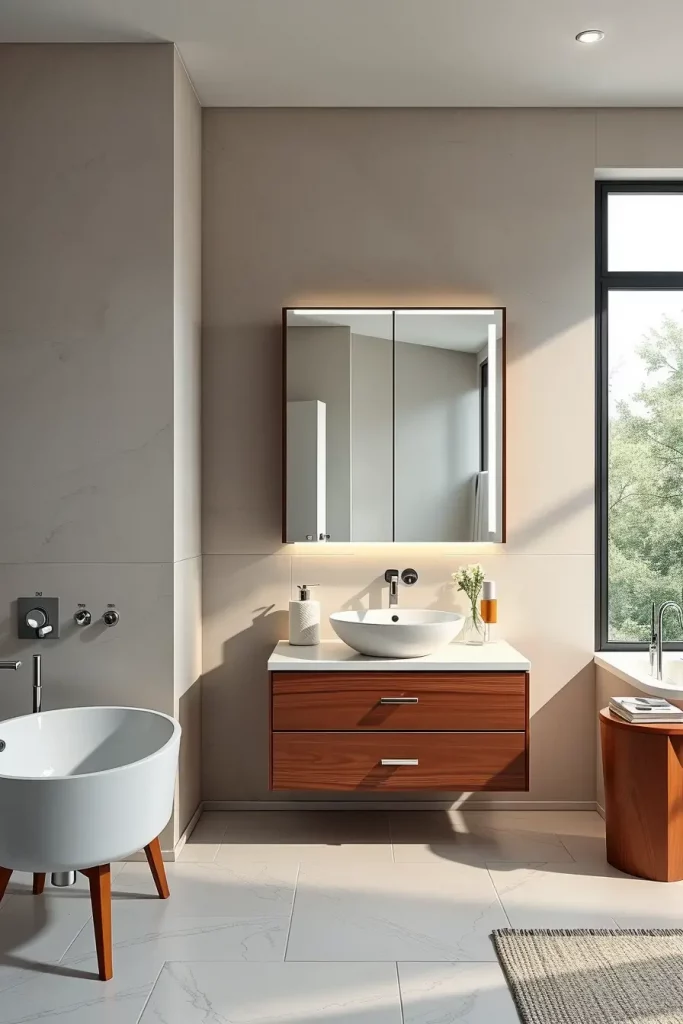
I usually prefer vanities that have clean geometric lines and flat-panel drawers and push-to-open mechanisms. The material is usually somewhere between matte lacquer and wood veneer, depending on whether the bathroom is more contemporary or warm. Under-cabinet LED lighting also gives it a high-end feel. The interior is designed with bespoke grooming tool, makeup and mini appliance compartments to facilitate maximum organization.

I have found that a floating vanity can make even the smallest powder room look bigger. I recall a project I was doing on a small city apartment bathroom and the client believed that no design would rescue the space. As soon as we put in a floating double vanity with recessed lights under it, it seemed to be twice as large. As Architectural Digest once noted, “floating cabinetry brings an instant architectural lift.”
To make this area even better, you might want to add a mirror cabinet above the vanity which has a built in demister and touch sensor, this would complete the storage and functionality without the clutter.
Minimalist Design With Clean Lines
Minimalism is not only a style, but it is a philosophy that runs deep in the modern bathroom design. I always tell people that clean lines will be the key to a visually restful environment. A minimalist bathroom is stripped down to the bare necessities but it is not cold. Here the form-function balance is crucial. It’s about simple materials, neutral color palettes, and uncluttered visual flow.

To accomplish this, I use large format tiles, floating fixtures and frameless mirrors. There are no handles on cabinetry, recessed lighting, even towel racks are discreet. I would use concealed plumbing and linear drains so that they do not interfere with the clean lines. At other instances I will use one accent like a matte black faucet to add some visual interest to the room but not to overwhelm it.

Clients often assume minimalist equals “boring,” but it’s quite the opposite when done right. I have witnessed people visibly relax when they enter a pared-down-but-considered space. The psychological effect of a serene, contemporary retreat can be astounding, in our overstimulated world.
An optional improvement in this would be to apply textured materials, which could be a ribbed stone wall or fluted wood vanity to create a sense of depth without losing the minimalist purpose.
Matte Black Fixtures For A Bold Statement
There is a reason why matte black bathroom fixtures are so popular nowadays they are impressive, elegant, and classic. I would suggest this style to anyone who would like to make a visual statement without using heavy ornamentation. Black makes a strong contrast, particularly in white or neutral bathrooms, and gives it a modern touch, which feels luxurious but still earthy.

The matte black finish is so versatile with so many different materials, whether it is the faucet, showerhead, towel bar, or even a wall-mounted toilet button, it looks great. It goes very well with natural stone, concrete and even wood. Above all, these finishes are long-lasting and conceal water spots better than polished chrome.
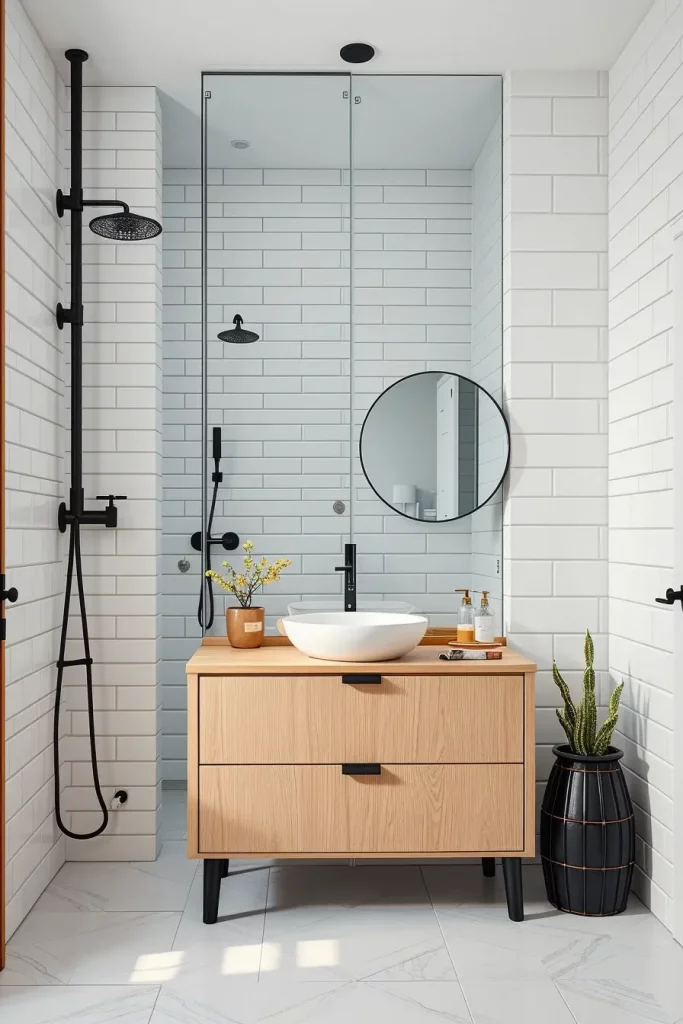
I especially liked the replacement of all chrome finishes with matte black. The result was dramatic but cohesive, and the client kept commenting on how “clean” everything felt—even visually. Elle Decor recommends using matte black to “create focal points that feel architectural in nature.”
To enhance this trend, I’d suggest pairing matte black with clear glass shower partitions or light oak vanities—it adds warmth and keeps the contrast elegant rather than stark.
Spa-Like Rainfall Showers
It is something transformative when you enter a rainfall shower. It immediately evokes the feeling of a luxury spa, and in modern bathrooms, it’s becoming a must-have. I consider these systems to be not only beautiful but very functional. They provide water to your entire body uniformly and can be mounted on the ceiling or embedded in a modern shower panel.
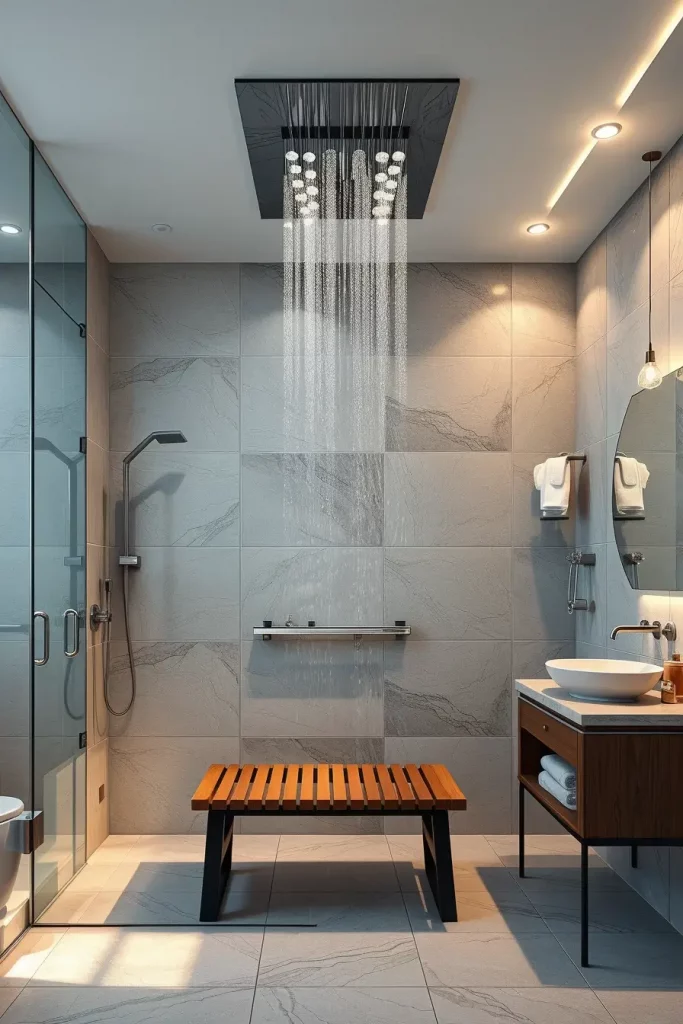
I tend to use square or round heads in brushed nickel or matte black with wall jets or handheld wands with my clients. A rainfall shower will go hand in hand with natural stone, frameless glass, and built-in benches to add to that relaxing, immersive experience. To increase the atmosphere, I would suggest installing aromatherapy steam outlets and LED lights on the ceiling.
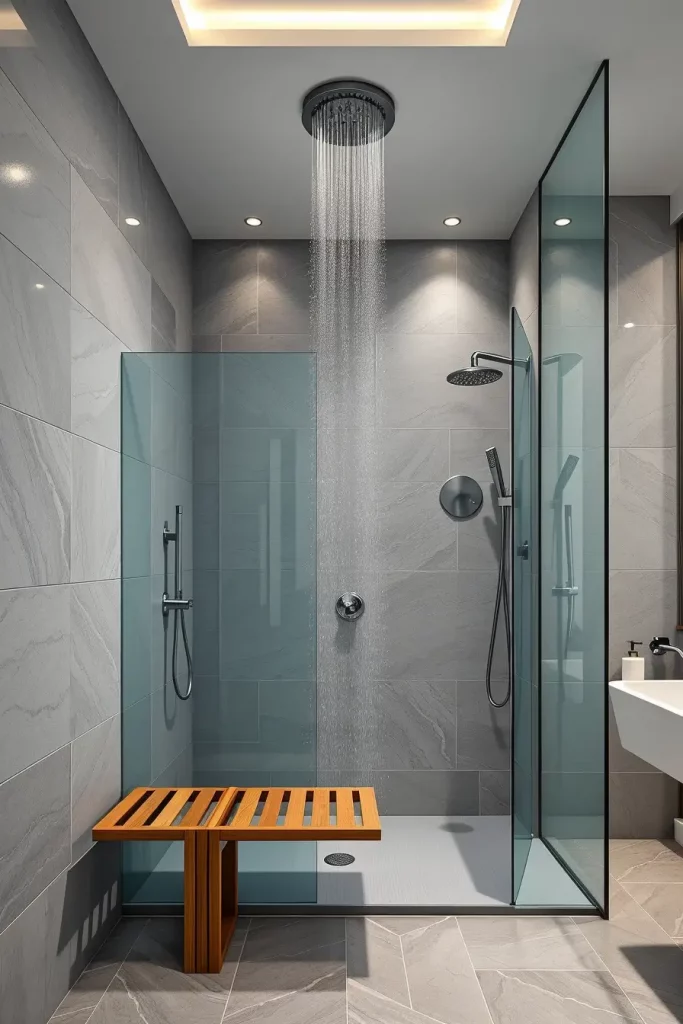
I recently remodeled a bathroom and paired a rainfall shower with a wall of smooth gray limestone and a floating teak bench. The client told me it was like “showering under a cloud.” Rainfall systems have also been identified by even Forbes Home as one of the key trends among people who want to find self-care havens.
You may include a niche shelf with soft lighting or a waterproof Bluetooth speaker to make the luxury experience complete.
Seamless Walk-In Showers Without Doors
One of the cleanest design moves you can make in a modern bathroom is a seamless walk-in shower with no doors. These showers remove visual and physical barriers and the room appears more open and accessible. I have applied this design in many small and large bathrooms due to the way it fits in the room so naturally.
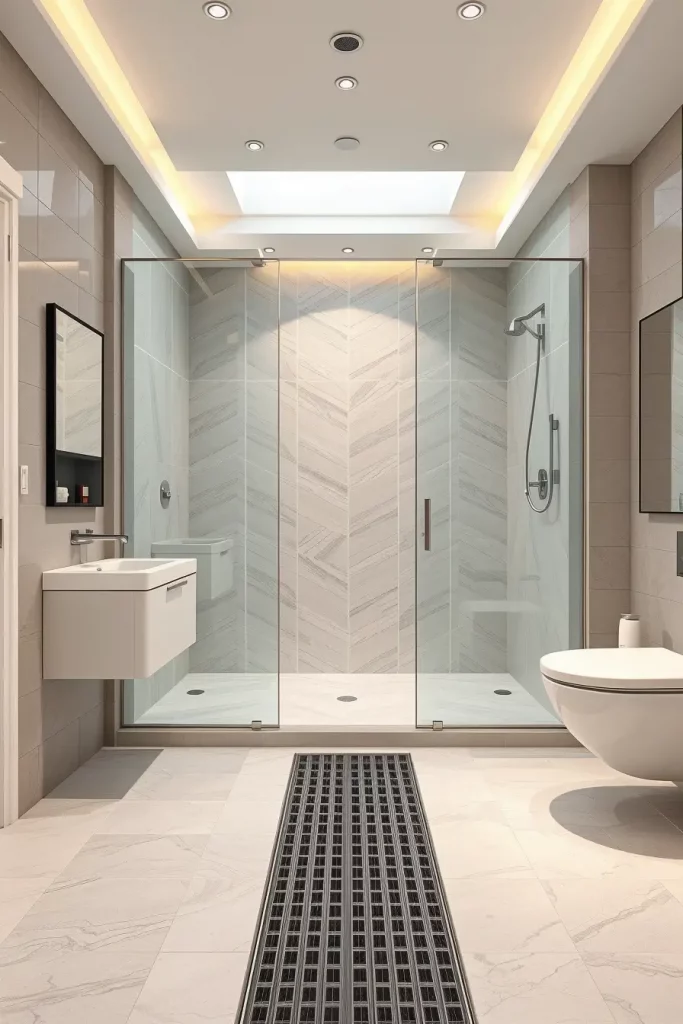
The trick is to apply continuous flooring, such as porcelain tiles or microcement, the bathroom and into the shower area. The water is channeled to a linear drain that is not visible by a small inclination. Frameless glass panels can be used to contain water but at times I use no panels at all when space permits. It produces an authentic spa effect.
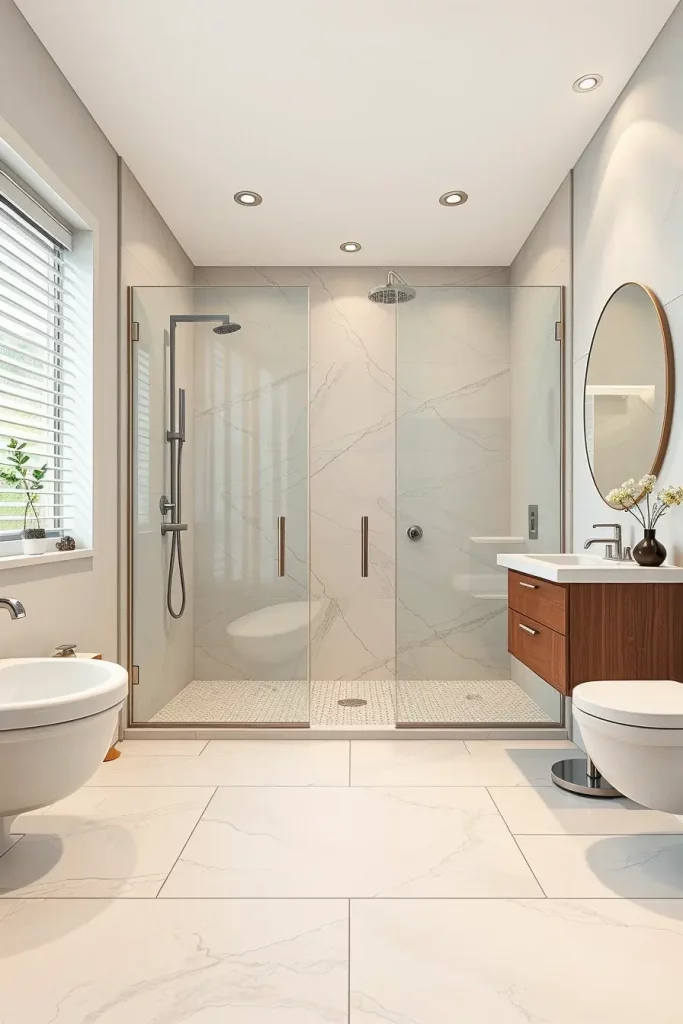
Personally, this design is a miracle in open-plan ensuite designs. One of my clients—a retired architect—said it made their morning routine feel “like stepping into a gallery, not a stall.” This trend was recently referred to by the New York Times as the future of accessible luxury.
I would add heated floors to the shower area and possibly a slatted wood stool to add a little comfort and warmth.
Statement Bathtubs As Focal Points
A statement bathtub is no longer an afterthought- it is the star of the show in most contemporary bathrooms. I adore prescribing sculptural, free standing tubs as visual focal points. They will draw the eye whether they are positioned next to a panoramic window or beneath a pendant light, and they will give the impression of luxury and calm.
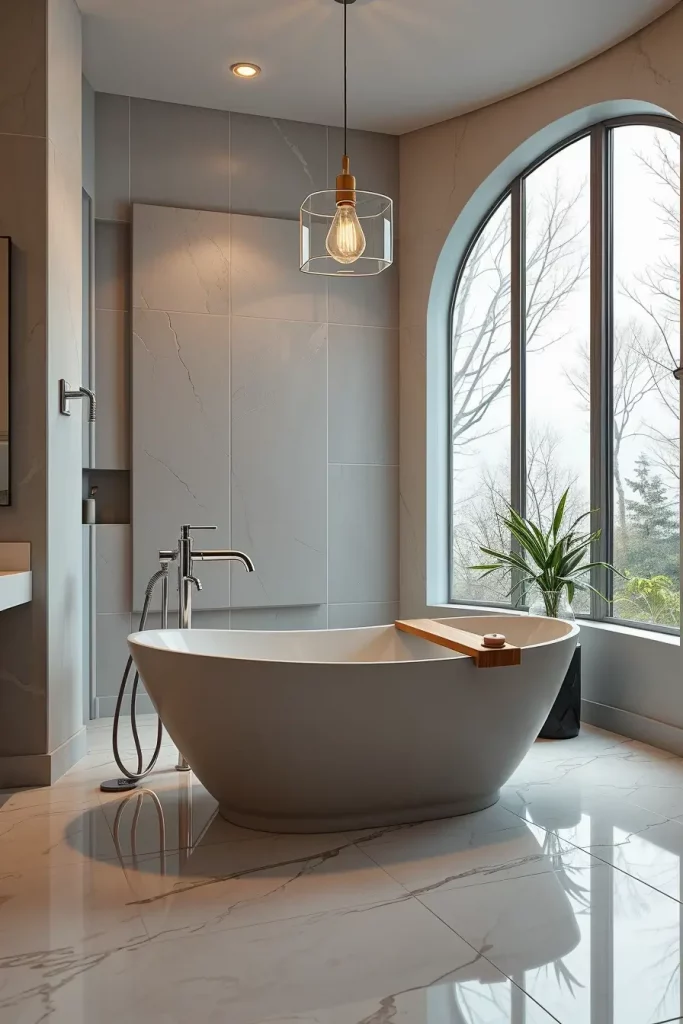
My favorites are oval resin, solid stone or even concrete bathtubs. I prefer models of matte finish and organic shapes. These are usually accompanied by a tub filler mounted on the floor, a side table that is minimalist and soft lighting around. The bathtub is no longer a washing place but a relaxation place.
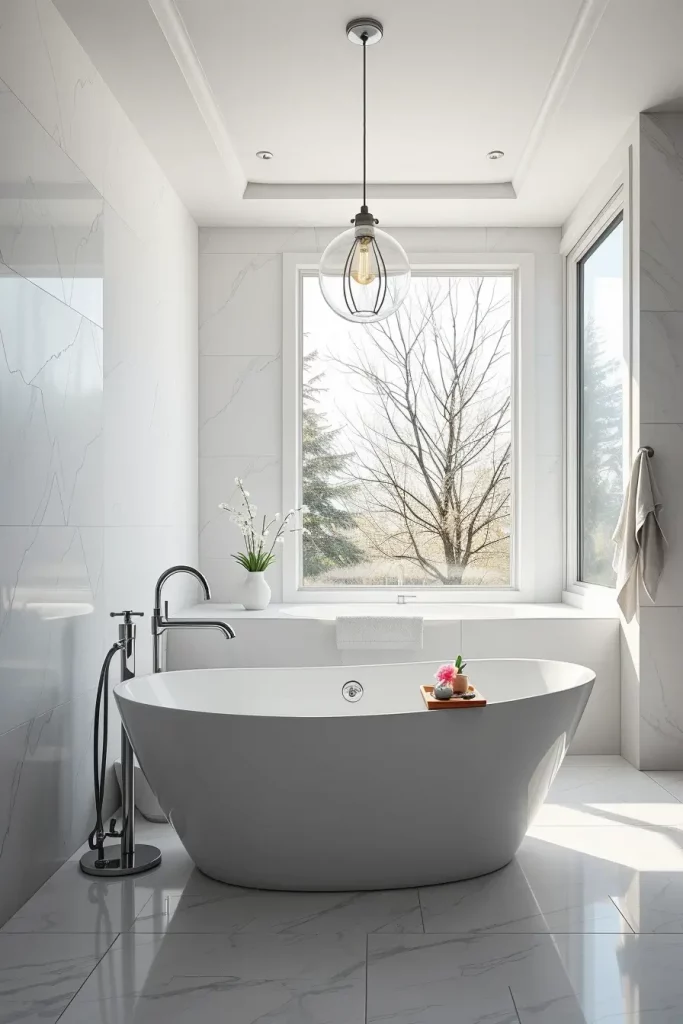
In one house, we put a deep soaking tub in front of a floor to ceiling picture window. The client informed me that it was their new favorite room in the house. According to Dwell Magazine: A tub is not only a utility, it is sculpture. And I concur.
To complete this scene, I would recommend floating shelves with rolled towels or teak bath tray to balance and serve a purpose.
Smart Bathroom Technology Integration
The kitchen and the living room are no longer the only places where technology is used. Smart technology is changing the way we live in the bathroom, including lighting and hygiene. I always start with assessing what the client requires- automated lighting? Voice-activated mirrors? Temperature-controlled flooring? These characteristics make life easier and enhance the everyday rituals.

Some of the most popular products I incorporate are smart toilets that have a built-in bidet, Bluetooth speaker systems, and shower valves that can be controlled via an app. Mirrors have defogging, touchless dimmer, and even date/weather widgets. I’ve worked on bathrooms that practically “wake up” when someone enters, using motion sensors and mood lighting.
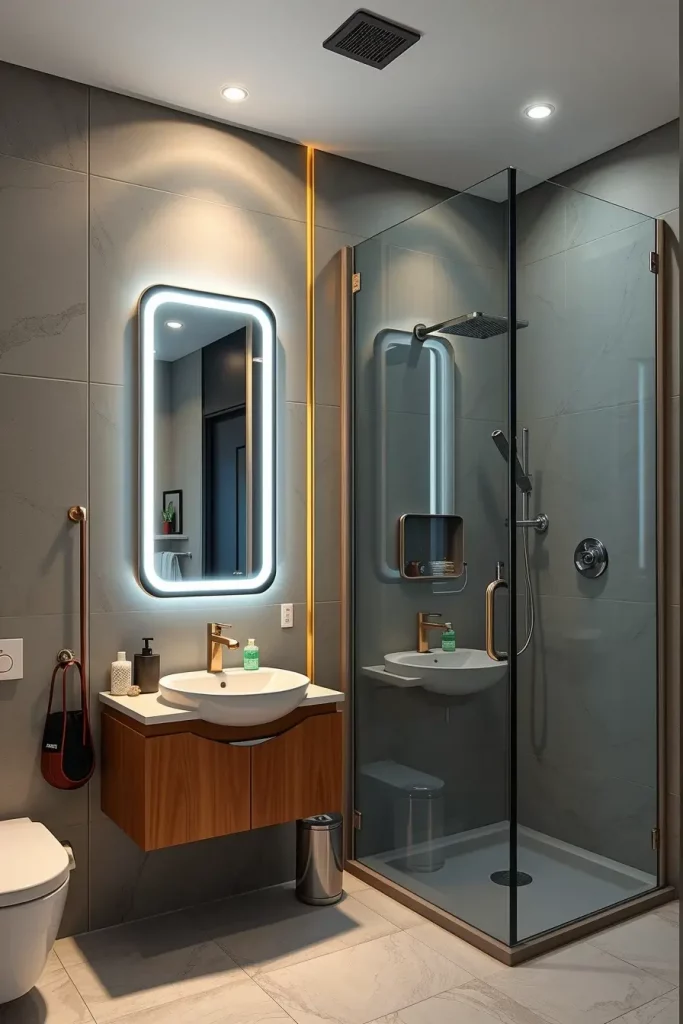
The clients are usually surprised at the ease with which these upgrades can be lived with. One even joked that his or her mirror now greets him or her better than his or her spouse. Industry analysts such as Houzz affirm that smart bathroom technologies are the leading renovation trends this year.
To finish this idea, I would add a charging drawer to the vanity to charge toothbrushes or razors, and intelligent ventilation systems to be energy efficient.
Wall-Mounted Toilets For Space Efficiency
The wall mounted toilet is one of the cleverest ideas that I usually propose in contemporary bathroom design. Not only are these fixtures sleek, they also allow maximum use of the floor space making the room appear more spacious and easier to clean. Wall-mounted models conceal the cistern behind the wall, so they can have a sleek appearance that perfectly suits minimalist or modern bathroom designs.
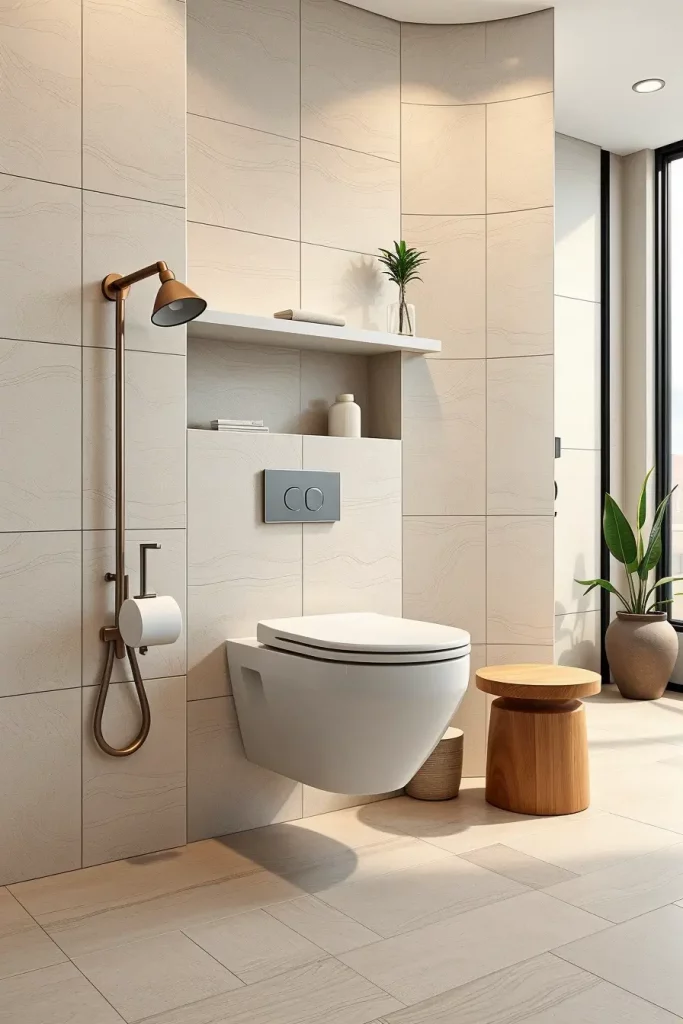
Design wise, I usually combine a wall hung toilet with large format tiles on the wall to make the eye go up. The flush plate is typically chrome, matte black or even glass depending on the color scheme. Open floor space below the toilet helps to improve airflow and a visual impression of lightness. I never miss to insist on the use of soft-close seats and rimless bowls in terms of hygiene and comfort.
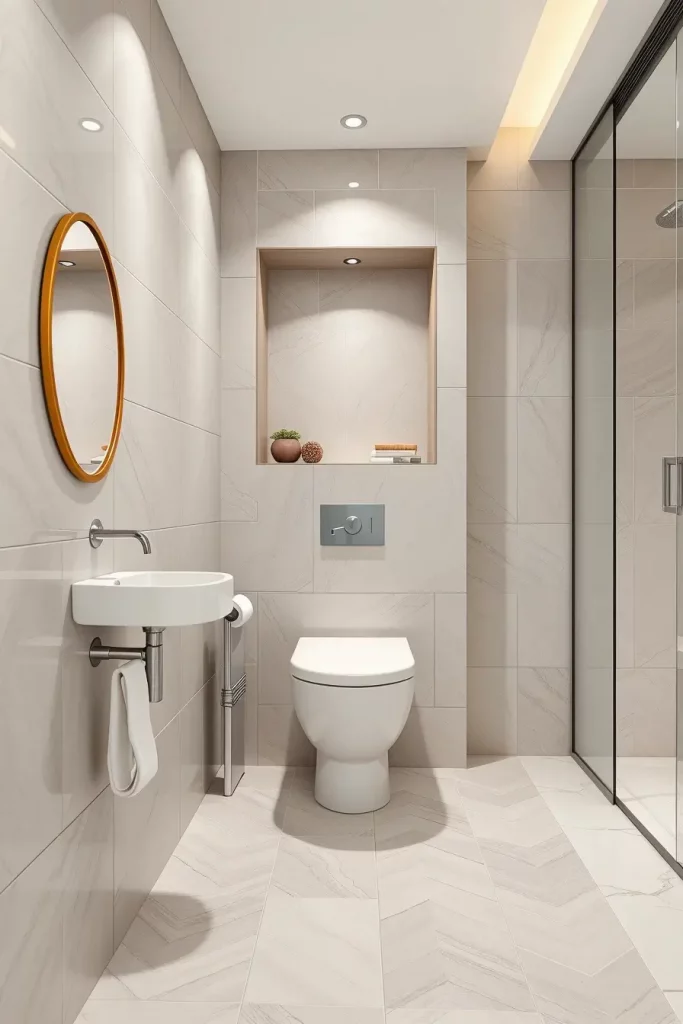
Personally, I have seen clients rave about how updated and hotel-like the bathroom is with this upgrade. It is also a huge success in smaller apartments or powder rooms. Even magazines such as Better Homes & Gardens are hinting that wall mounted toilets are the way to go in designing a more efficient, modern bathroom.
To further complete this idea, I would recommend a recessed shelf above the toilet to add storage or decorative items such as candles or rolled towels.
Backlit Mirrors With LED Lighting
The backlit LED mirror is one of the features that I do not miss in a modern bathroom. These mirrors are both practical and beautiful. The faint light around the edges provides depth, removes shadows, and makes the atmosphere calm-especially when the other lights are dimmed. They’re perfect for both task lighting and creating a relaxing atmosphere.

I like rectangular or round mirrors, frameless, depending on the design. Most of them are provided with touch controls, dimmers, anti-fog, and even clocks. I will always put them over floating vanities so that the clean, vertical lines are maintained. When the LED tone is set to daylight white, it is perfect to use in grooming activities but without the harsh overhead lighting.

I have personally found these mirrors to be one of the most simple upgrades with the most visual reward. In fact, one client told me their guests always comment on the mirror first! HGTV states that LED mirrors are one of the most popular energy-efficient and smart bathroom upgrades.
The only addition I would make to this look would be to add wall sconces on each side to have layered light or a light accent wall behind the mirror to add to the glow effect.
Open Shelving For Airy Storage
There is a role of traditional cabinetry, but open shelving is a game changer in the contemporary bathroom design. I would suggest this to anyone who would like to have a balance between storage and looks. Open shelves also help a bathroom look less closed-in and more stylish, such as towels rolled up, glass jars of cotton rounds, or small indoor succulents to add a fresh touch.
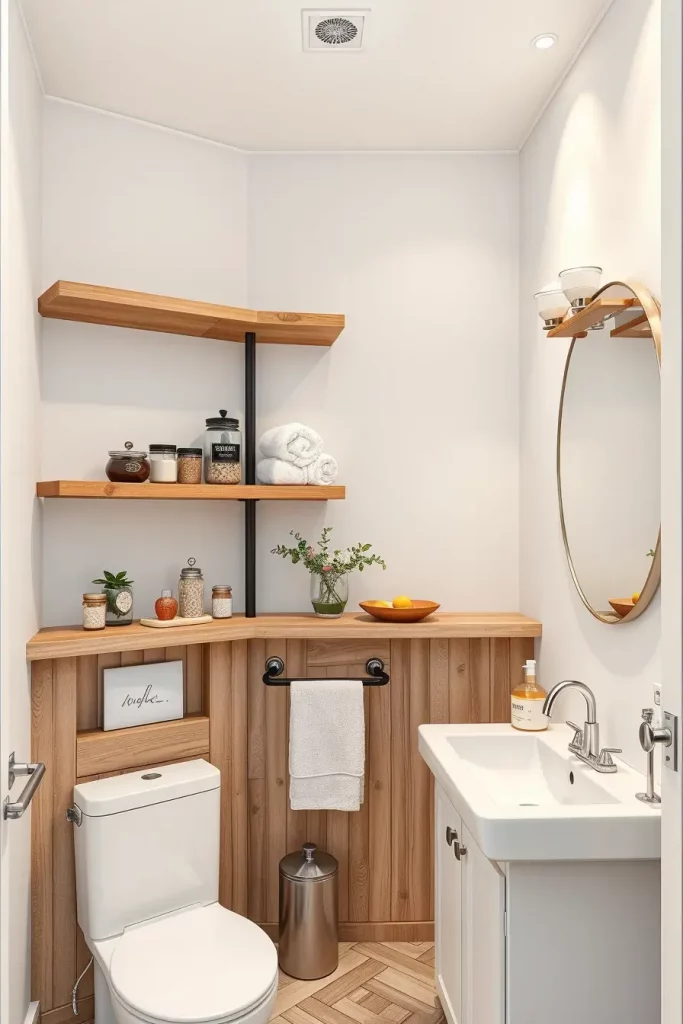
I usually work with wooden or metal shelves, which depend on the general palette. As an example, black steel brackets look good with matte black fixtures, whereas light oak suits neutral or Scandinavian-style bathrooms. These shelves often go above the toilet, beside the vanity, or even inside the shower zone (with waterproof materials, of course).
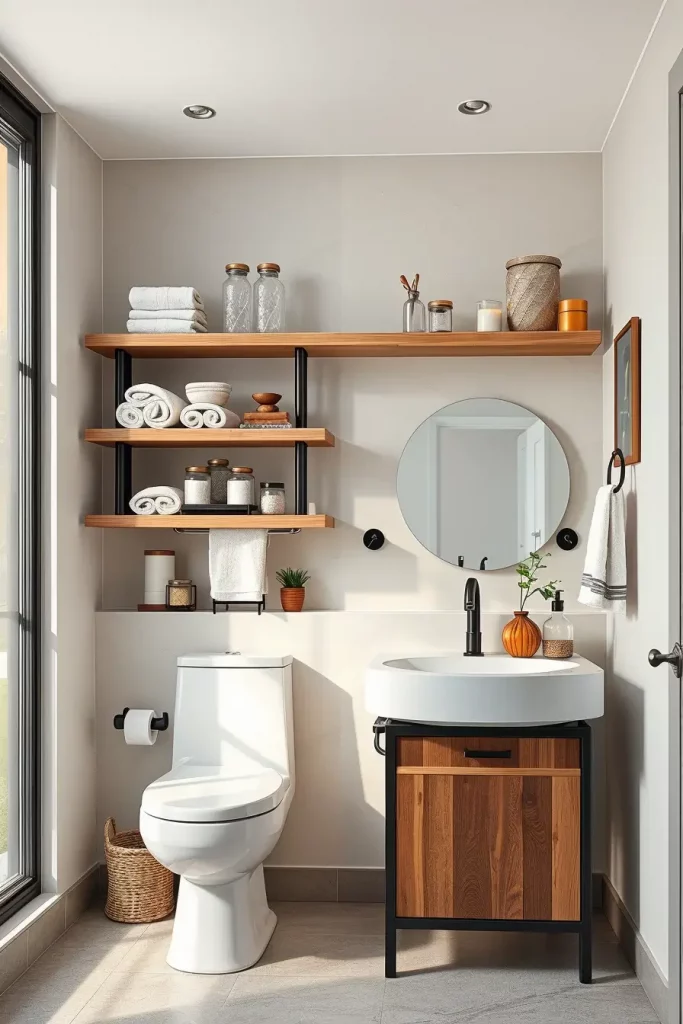
Clients like the convenience and the fact that it is easy to change decor. I have done a guest bath with three floating walnut shelves that turned a formerly bland wall into a top-end focal point. The open shelving, as Apartment Therapy observes, introduces the aspect of breathability and personality to the utilitarian spaces.
The one thing that I would add to increase utility would be under-shelf lighting or a combination of open and closed storage to conceal less appealing items such as cleaning supplies.
Natural Stone Accents And Textures
The introduction of natural materials is an eternal method of grounding any interior, and the texture of stone in the interior of a modern bathroom introduces not only elegance but also a sense of touch. Marble, travertine, slate, or any other of these surfaces provide a tactile experience that no synthetic material can provide. I prefer to apply them on walls, floors, countertops, and even sinks to make everything to fit together.
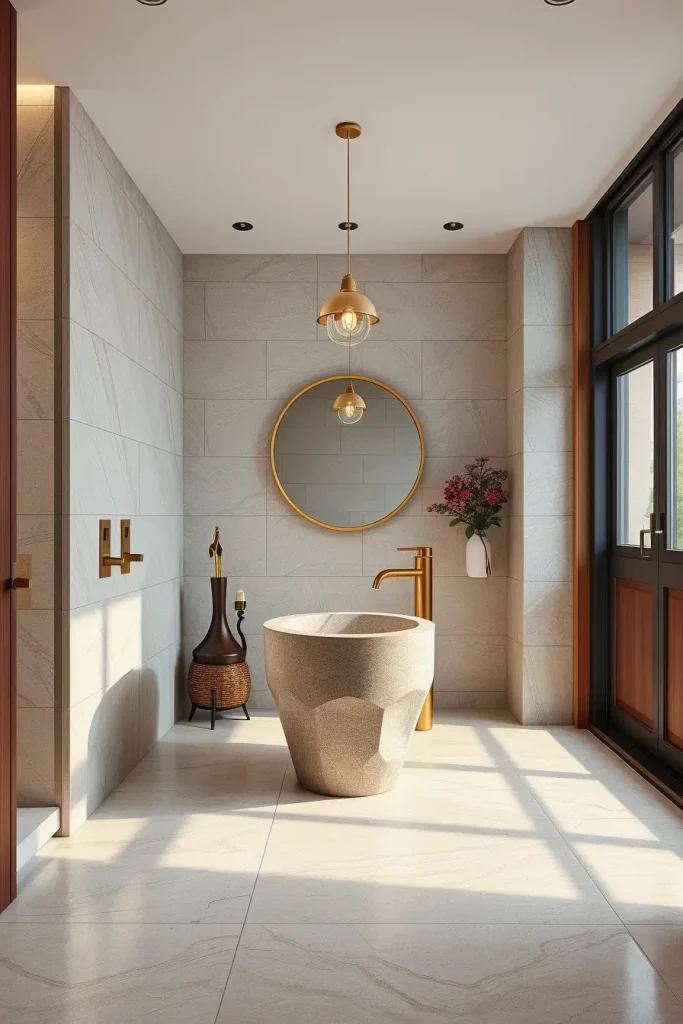
One of my favorite combinations is honed limestone wall tiles and solid stone basin in a similar tone. I usually suggest quartzite as a countertop because it is durable and has organic veining. In bathrooms where the tub is a statement piece, I will use stone as a feature wall behind the tub, whether in panels or in textured slabs with light that throws shadows.
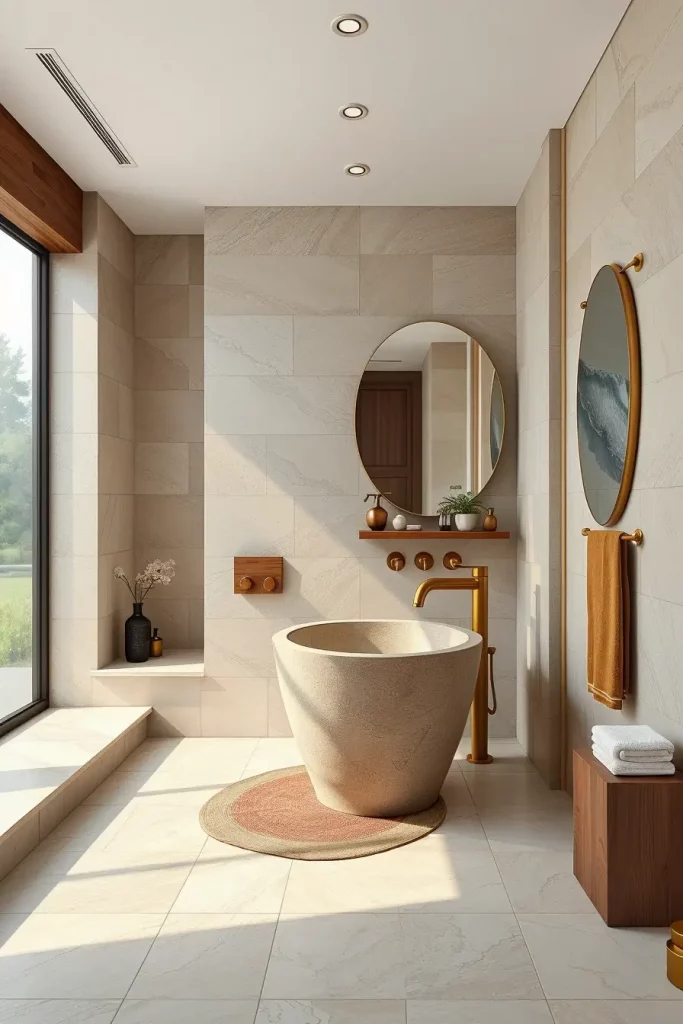
Stone is warm and elegant without being too much. One of my clients called it “effortless luxury,” and I couldn’t agree more. Veranda magazine calls natural stone an essential ingredient of eternal luxury in the bathroom design, particularly in combination with minimalist lines.
To make the appearance even more luxurious, I would introduce matte finishes or brushed brass fixtures or wooden details to make the overall impression less harsh and cold.
Large Format Tiles With Minimal Grout Lines
Large format tiles make a difference in a really modern bathroom. These large format slabs (porcelain or stone) ensure a smooth surface with few grout lines, which makes the space look bigger and much easier to keep clean. I would suggest them frequently on walls, floors, and even in showers.

The best ones I would choose are 24×48-inch porcelain tiles that resemble natural stone or concrete. They are installed with thin grout lines to make them have a continuous flow. This design decision minimizes visual noise and increases the minimalism. I also prefer to use the same tile on many surfaces-wall to floor- to achieve a monolithic effect.

In one project, I used extra-large terrazzo-look tiles across a small bathroom, and the client was amazed at how it “doubled” the size visually. According to Domino magazine, big tiles are a favorite of designers because they help to minimize maintenance and expand perceived space.
To finish the look, I would recommend a similar grout color, built-in floor drains and maybe a recessed wall niche to have built-in storage without disrupting the visual flow.
Freestanding Basins In Artistic Shapes
Stand alone basins are taking a very serious turn in the contemporary bathroom design. These sculptural sinks are functional and focal unlike the typical under-mount sinks. I adore defining unusual forms, such as round, oval, square, or even organic irregular, to clients who want to break the mold, yet keep it elegant.

I usually combine a freestanding stone or ceramic basin with a narrow pedestal base or wall-mounted faucet most of the time to maintain the sightlines. Depending on the general atmosphere of the place, materials vary, going between matte concrete and natural travertine. These basins appear particularly impressive when they are mounted on minimalistic vanities or floating consoles.
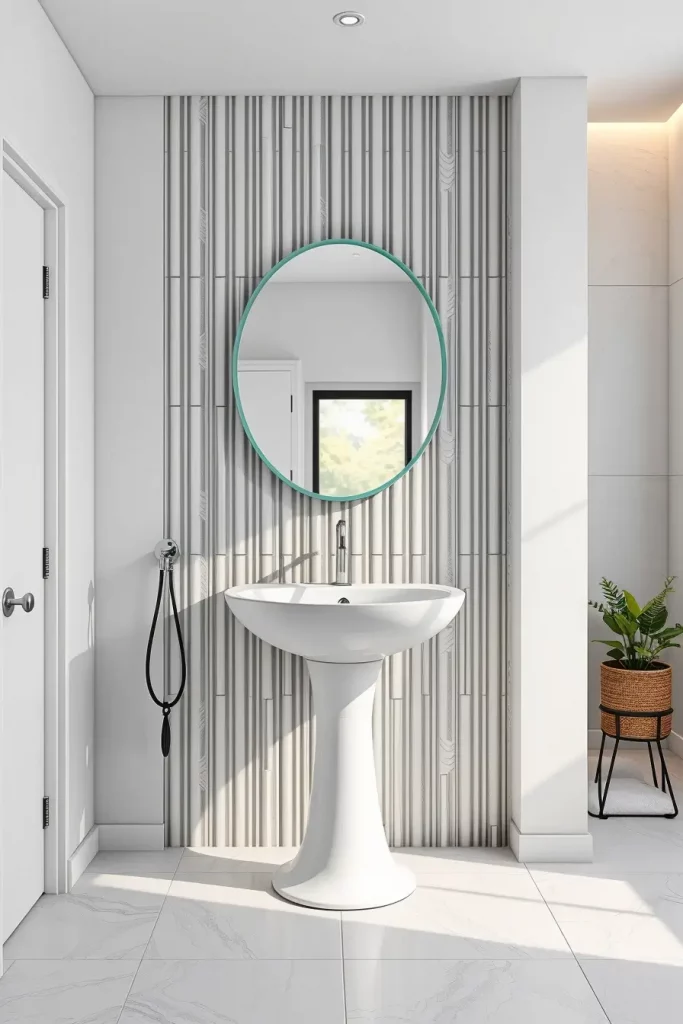
In my personal opinion, I believe that such artistic sinks are a great method of style expression in a practical object. One of my favorite designers once told me, that your bathroom sink is the jewelry of the room and I completely agree. They look particularly good in powder rooms where you can be more playful.
What I would like to add here is a background of vertical tiles or a curved mirror to balance the organic shape of the basin and make a unified sculptural composition.
Monochromatic Color Schemes
A monochromatic color scheme when properly implemented introduces elegance, balance and focus in a modern bathroom. All whites, all grays, or all earthy tones, the trick is to layer textures within the same tonal family. I tend to do this when I am interested in form and material but do not want to be distracted.
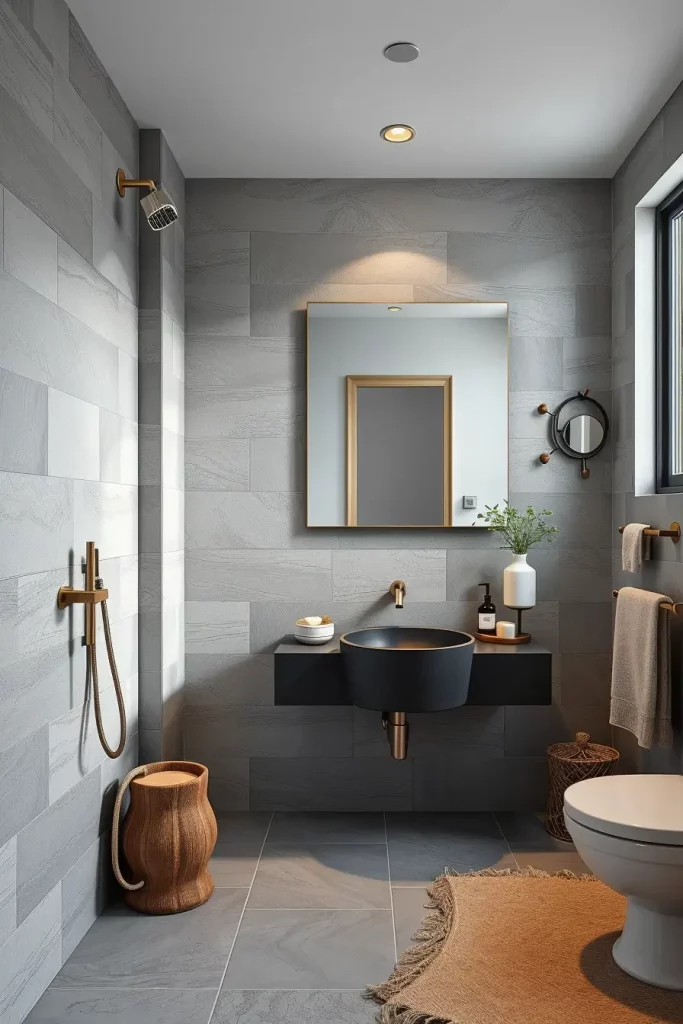
I use finishes, like matte tiles, polished countertops, and textured plaster, within a single color story to create a robust monochrome palette. As an example, a gentle gray scheme could have light concrete floors, mid-gray walls, a charcoal basin, and brushed nickel fittings. Not being flat, but depth in restraint.
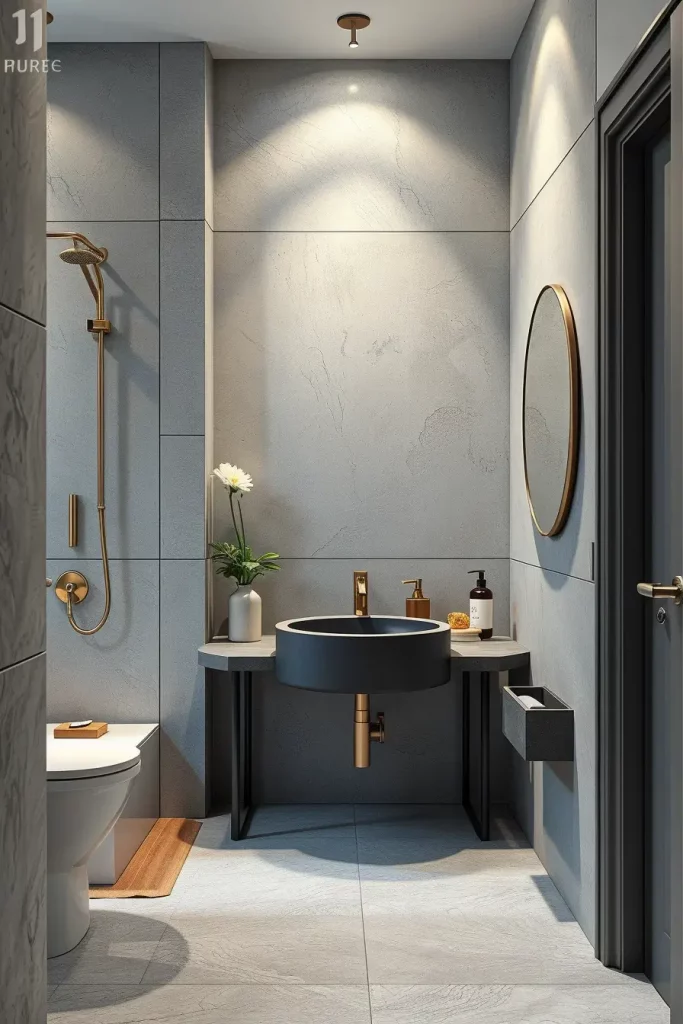
Based on my experience, clients are shocked by the versatility of monochrome. One even said they would never consider using mixed palettes again after having lived with an all-beige suite that was warm, stylish and cohesive. Elle Decor points out that monochrome is not dull, it is strong when used with intent.
To make this design even better, I would recommend to add one contrasting element, e.g. a plant or a black-framed mirror, to serve as a visual break without destroying the harmony.
Warm Metallic Accents Like Brushed Brass
Warm metallic accents such as brushed brass are my go-to choice in modern bathrooms as they create a hint of luxury and sophistication to even the most minimalist design. Brushed brass is a good choice when applied on fixtures such as faucets, handles, and lighting trims as it goes with both cool and warm color schemes without dominating the balance of the room. It is an excellent method of adding character and refinement particularly in neutral or monochromatic designs.
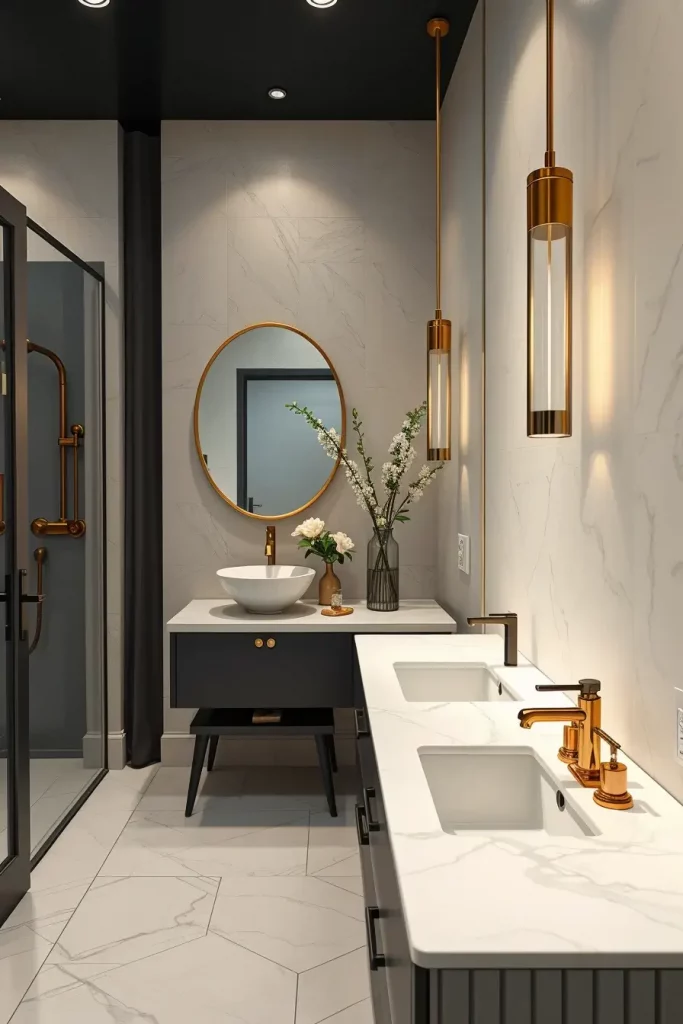
I incorporate brushed brass into my designs by using things such as mirror frames, towel bars and even hidden shower valves. These accents are beautiful with matte finishes, marble and glass partitions. Brushed brass does not display water spots as readily as polished chrome, and thus is more practical in the long term in high-use locations.
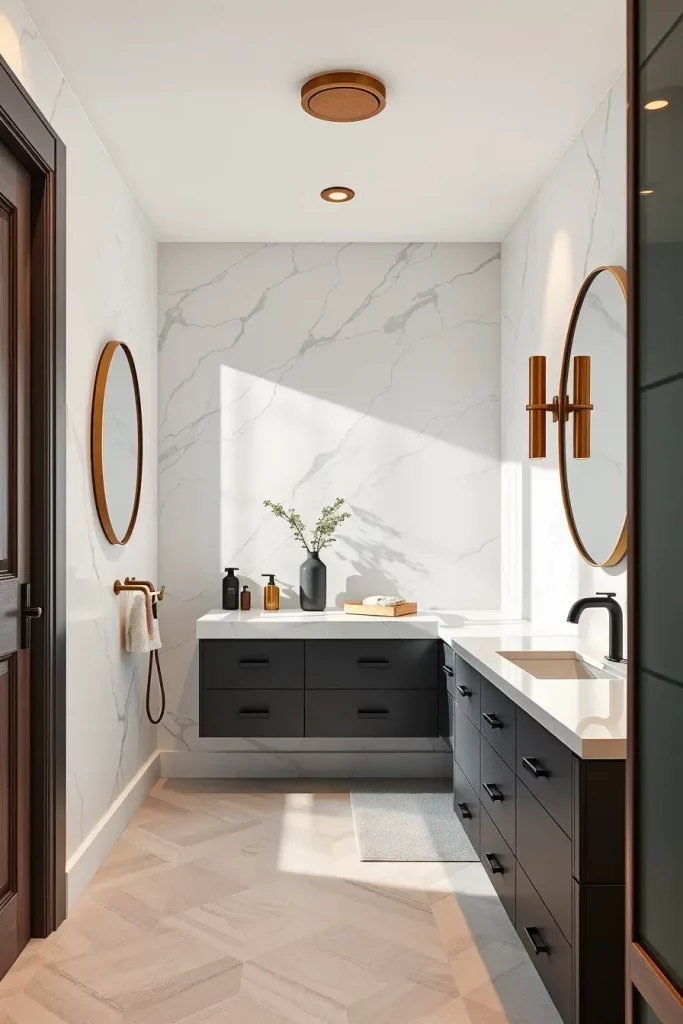
In my personal experience, brushed brass has a feeling of deliberate luxury. Architectural Digest also cites the use of warm metallics in bathrooms as one of the most powerful material trends this year, especially since it adds visual warmth to an otherwise sterile setting. I completely concur brushed brass is fresh, warm and grounded.
To anyone who would like to improve this design further, I would advise that they add under-cabinet lighting or a similar metallic pendant lamp. It assists in uniting the theme and balancing the space.
Floating Wood Cabinets For Organic Touch
I love floating wood cabinets as they add a touch of nature to otherwise hard surfaced bathrooms. Floating furniture gives the appearance of space, which expands floor spaces, even in a small room. These cabinets provide a warm, earthy texture, which is compatible with ceramic, stone, and modern matte surfaces.
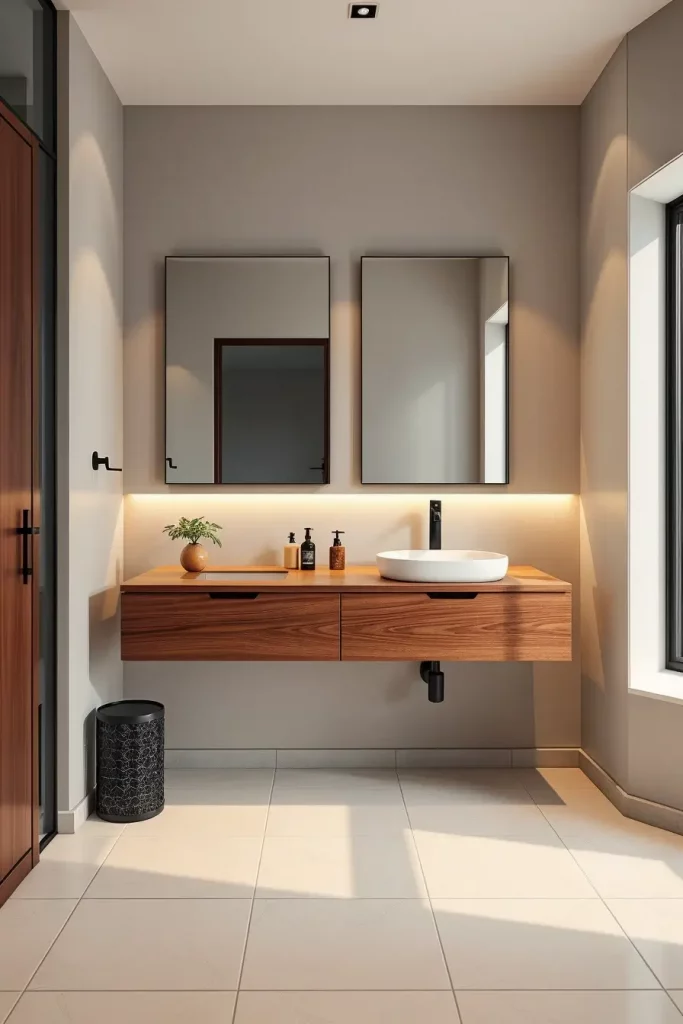
I like clean-lined woods such as walnut or oak with soft grain patterns when designing with floating vanities. The sleek look is maintained by drawers that have concealed handles and push-to-open mechanisms. The minimalist look is augmented by integrated sinks and seamless countertops. I have also discovered that a soft LED strip under the cabinet will make the floating effect even more noticeable at night.
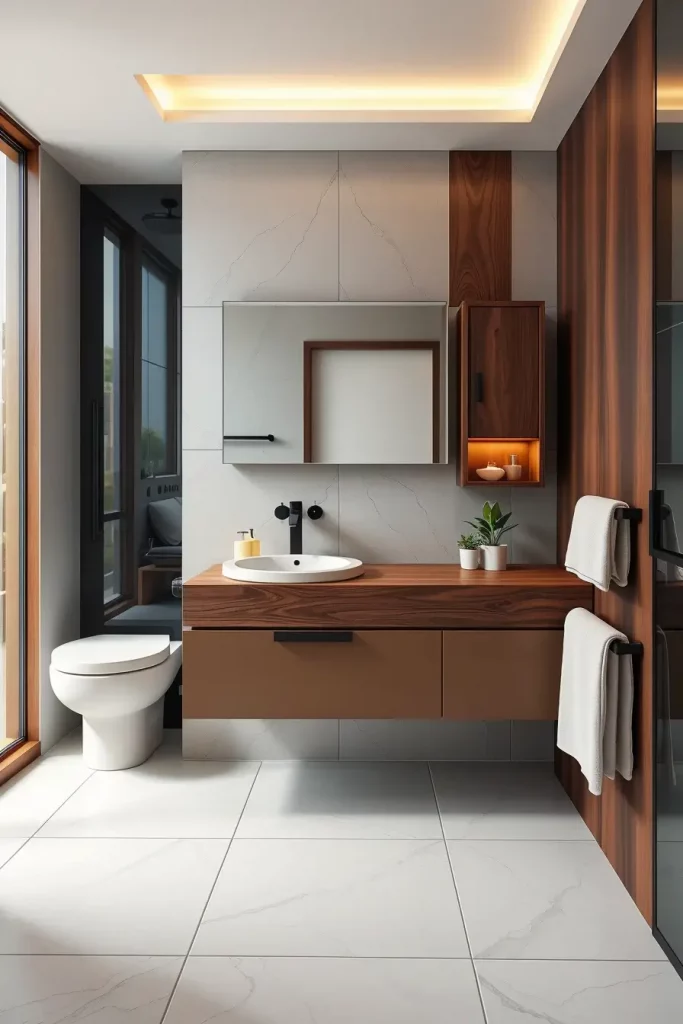
This is a trend that I can relate to since it relates modern design to nature. Elle Decor points out that more and more homeowners are choosing wooden bathroom furniture to avoid cold all-white schemes. I have observed the emotional reaction of clients to this texture, it makes the room experience soft.
A change I would make is to add linen-like towels and recycled ceramic accessories to finish the organic narrative. These facts support the earthy modern style.
Frameless Shower Enclosures For Transparency
Modern bathroom design is based on frameless glass enclosures. I enjoy the way they make the shower feel like it is part of the rest of the room and there is no visual break. They eliminate the visual obstacles present in the older styles and focus on the flow of light and clean lines- perfect in small or dark rooms.
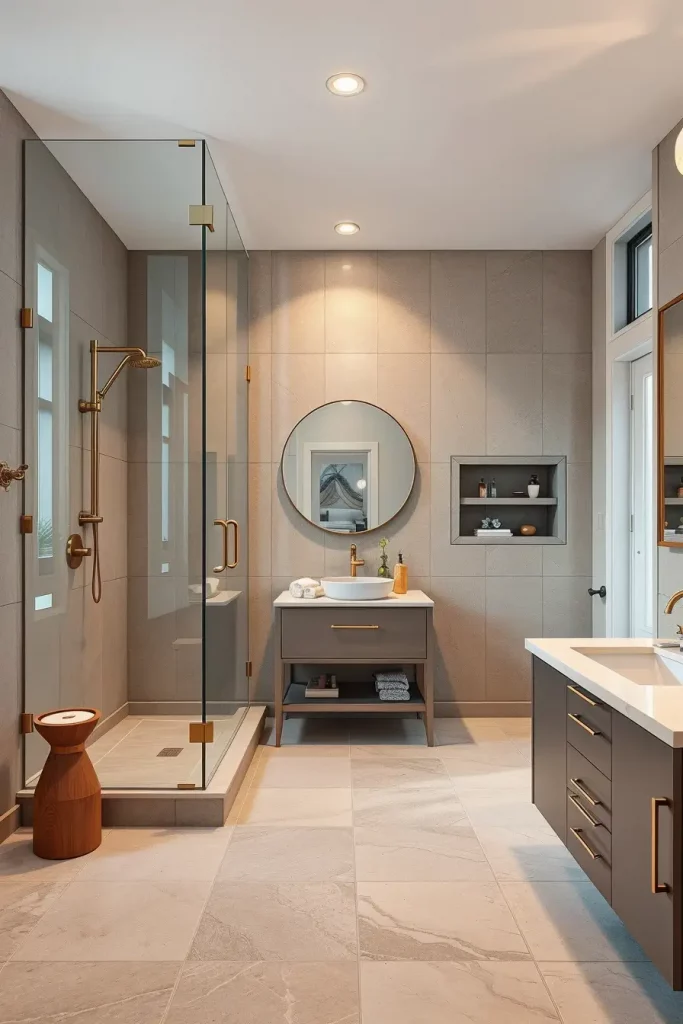
These showers require minimal hardware, and this can be as little as wall clips and smooth hinges. I also specify tempered glass because of its durability and safety and anti-lime coatings to minimize maintenance. For a cohesive look, I align the metal details (if any) with other warm metallic accents in the room.
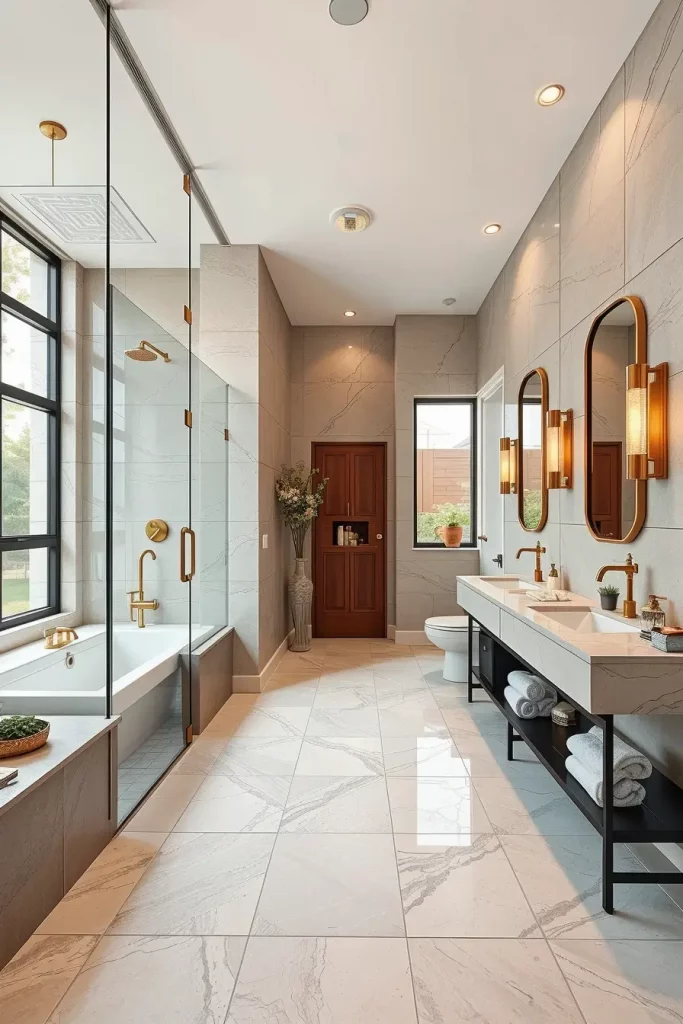
Clients are always reporting that they feel their bathrooms are bigger and spa-like with the frameless enclosures. This trend was recently discussed on HGTV as one of the major updates to raise the resale value of the home due to its high-end look. I concur it is architectural and airy.
I’d recommend adding a linear drain or curbless entry (which I’ll describe later) to amplify the uninterrupted flow in the design.
Soft, Ambient Lighting Layers
The layered lighting is soft, which turns the bathroom into a relaxing retreat instead of a purely functional space. My rule of thumb is to begin with ambient light, which is most often built into the ceiling or placed around mirrors, and to add accent lights and task lights. The mixture prevents the appearance of severe shadows and accentuates textures and shapes.
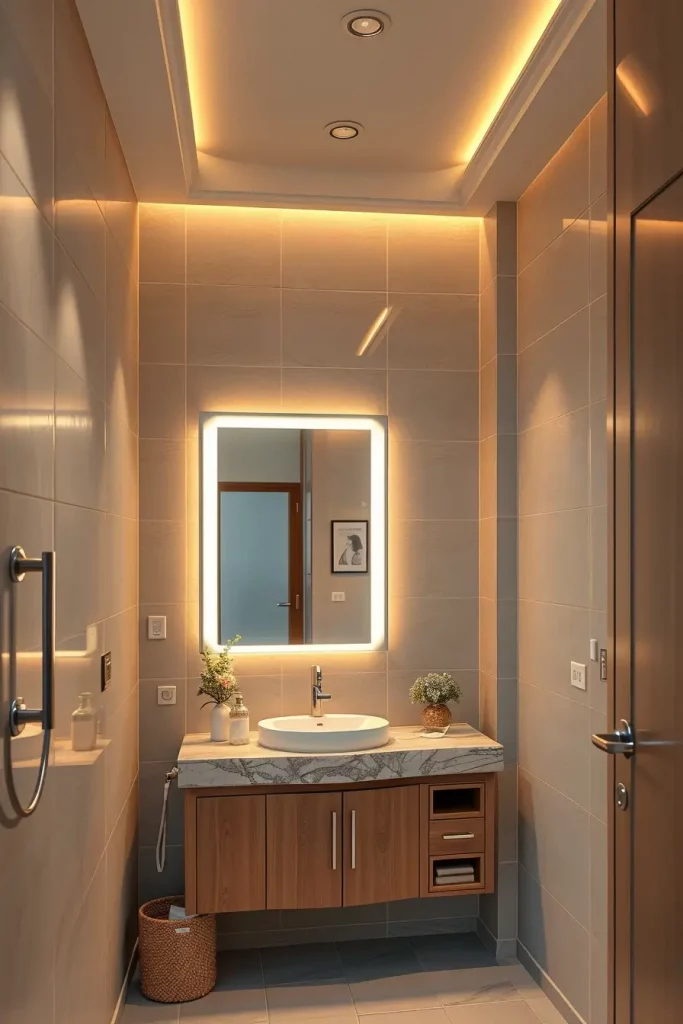
In the case of fixtures, I prefer dimmable LED strips behind mirrors, under floating cabinets and around the perimeter ceiling. Warm-tone bulbs (2700K–3000K) make the room feel more inviting, especially when combined with metallic finishes or natural wood. Mood and style can also be influenced with the help of accent sconces.
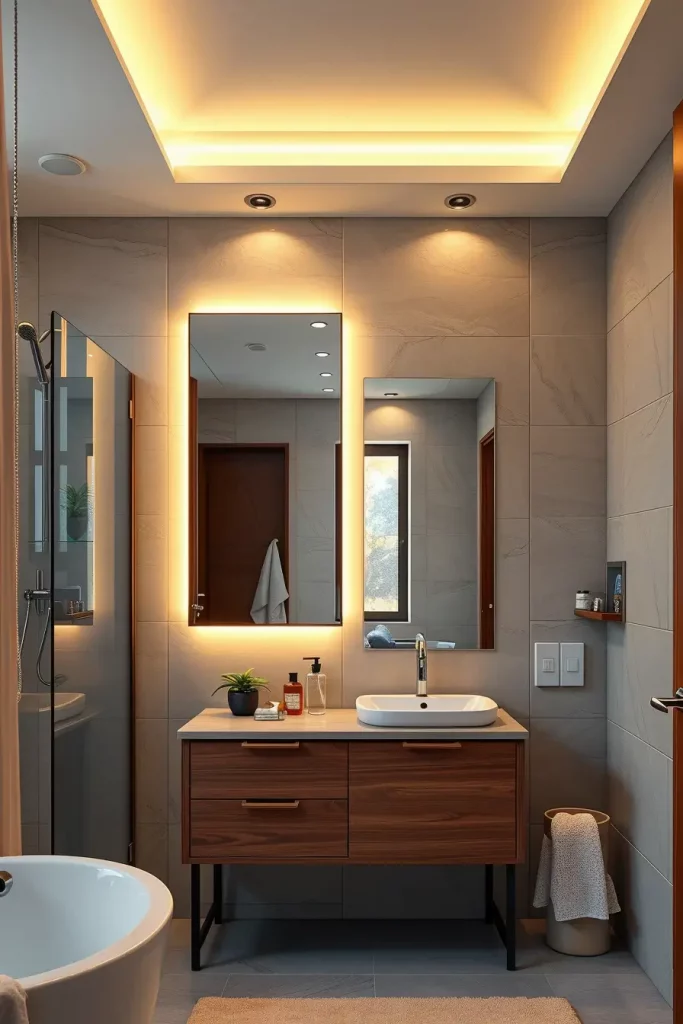
In my experience, the least used feature in bathrooms is ambient lighting. According to Better Homes & Gardens, the right amount of lighting does not only enhance usability, but also the perceived value of the space. I have had clients come back to tell me how much the layered lighting has enhanced their mornings.
The final touch to this style is usually the incorporation of an intelligent lighting system- enabling day or night pre-set scenes. That last convenience is a difference that is felt.
Industrial Chic Elements Like Exposed Pipes
Not all modern bathrooms need to be smooth and shiny, industrial chic brings the boldness and contrast using raw materials such as exposed piping, concrete textures and matte black details. I prefer to use this appearance when a client wants something modern yet edgy. It works especially well in city apartments or loft conversions.
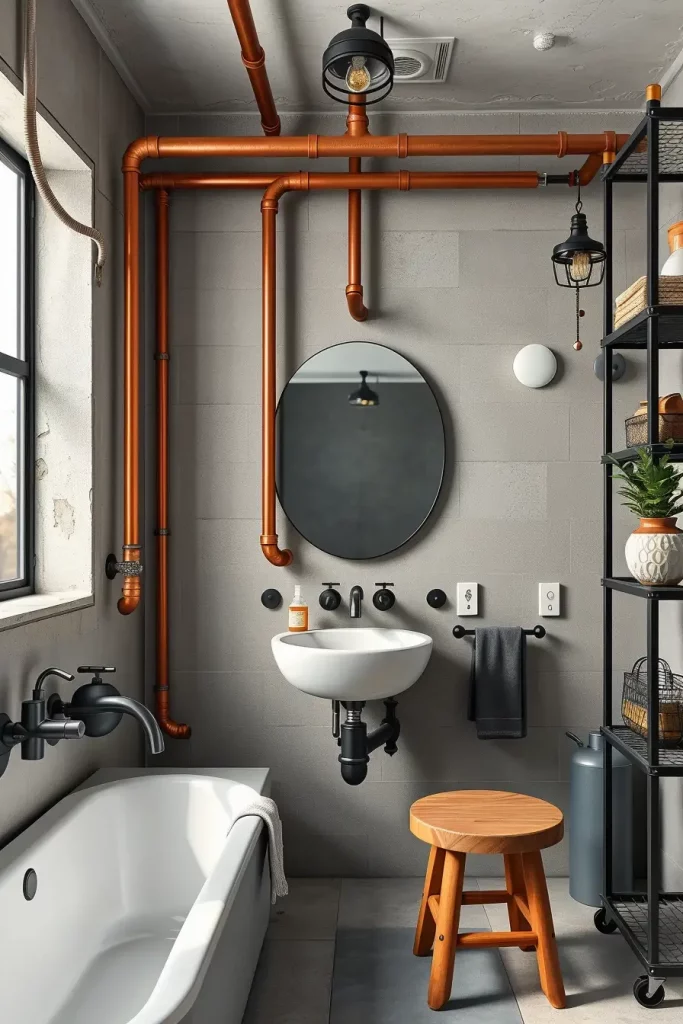
In order to maintain the style purposeful, I apply coordinated matte black fixtures, visible brass or copper pipes, and concrete-look porcelain tiles. I also put some wire-frame shelves or iron towel racks to counterbalance the roughness with functionality. Incorporation of wood such as a floating vanity or stool avoids the coldness of the space.
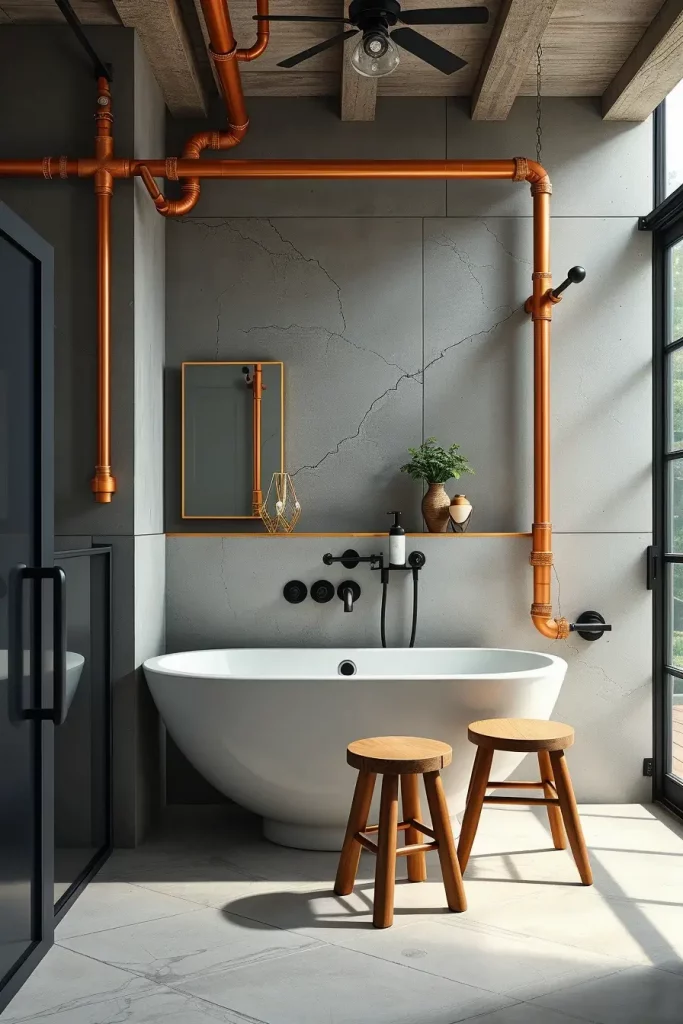
I like to design in this style personally as it combines modern bathroom furniture and architectural honesty. Dwell Magazine refers to this style as minimal with character and I have witnessed this style gain popularity in the renovation of older buildings.
The thing that might take this space to the next level is the use of soft textiles, such as waffle-knit towels or a warm bath mat, to balance out the visual and provide contrast.
Terrazzo Surfaces In Floors And Walls
Terrazzo has had a resurgence in contemporary bathrooms and I adore it as a way to introduce some fun texture and visual depth. Terrazzo is durable, water resistant, and the speckled appearance is immediately a focal point whether used on walls, floors, or countertops.
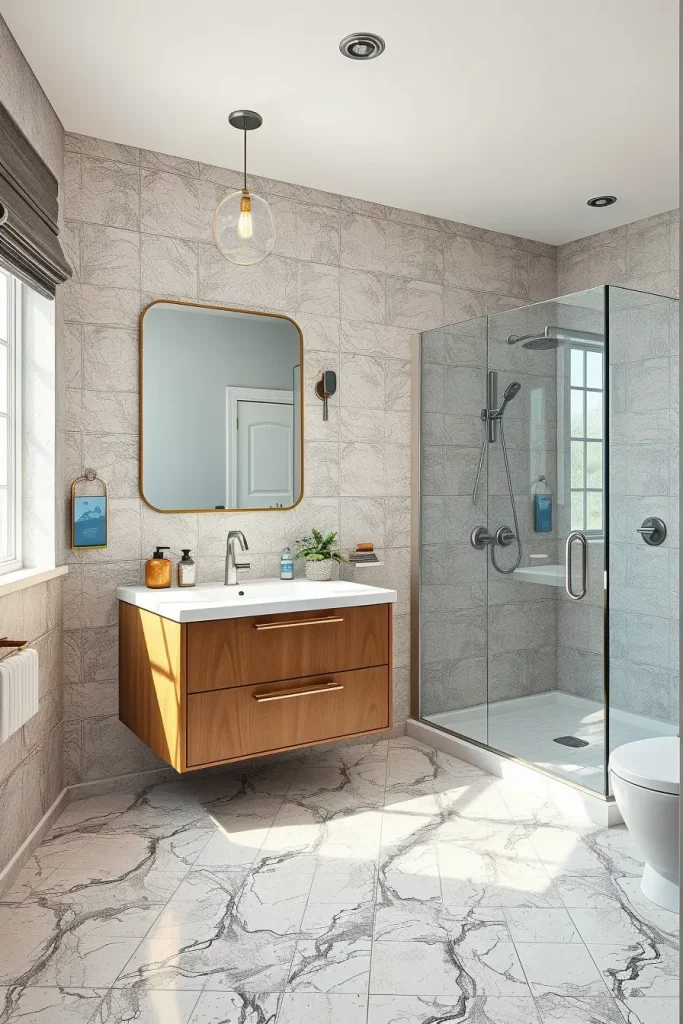
To prevent competing patterns, I tend to use the terrazzo flooring with white or soft gray walls and simple floating wood cabinets. Terrazzo slabs in large format are ideal to reduce grout lines and the material can be used with glass partitions and frameless showers.
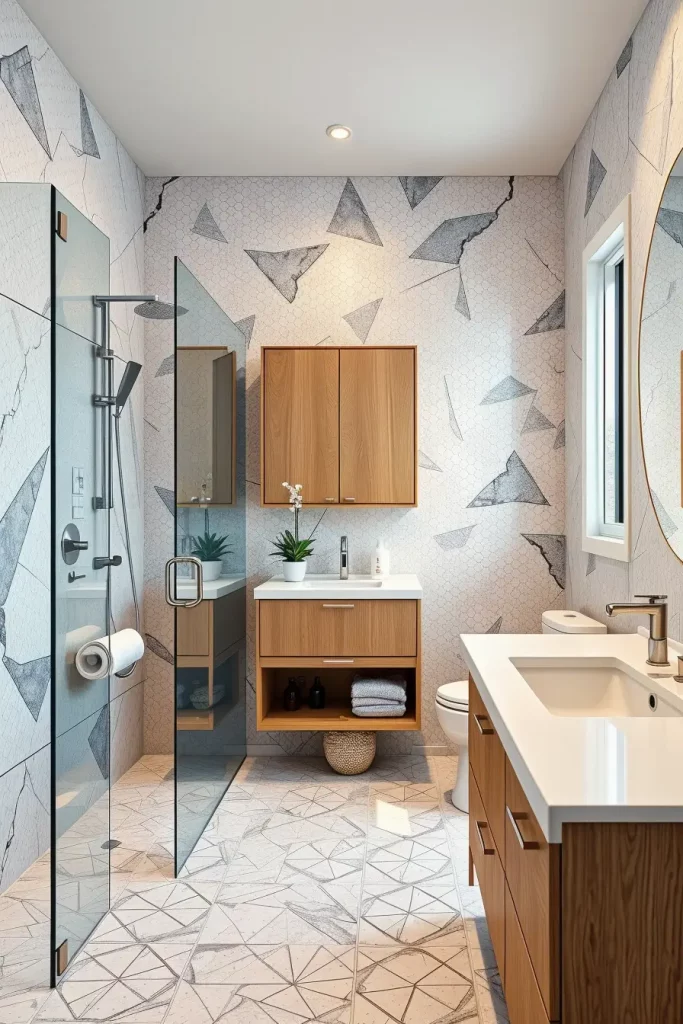
This is a trend that is refreshing as it creates a break in the monotony of surfaces. Recently Domino Magazine called terrazzo timeless with personality, and I couldn t agree more. I have had clients select their own mix of stone chips and color to suit their taste.
To extend this idea, I would recommend a rounded-edge mirror or terrazzo accessories such as soap dishes or trays. These minor details resonate with the rest of the design without dominating over it.
Curbless Shower Floors For Accessibility
Modern necessity that combines design with accessibility is curbless, or zero-threshold showers. I adore the way they allow a clean, uninterrupted floor line which not only enhances accessibility but also gives a minimalist touch. These showers appear particularly impressive when combined with large format tiles or poured microcement floors.
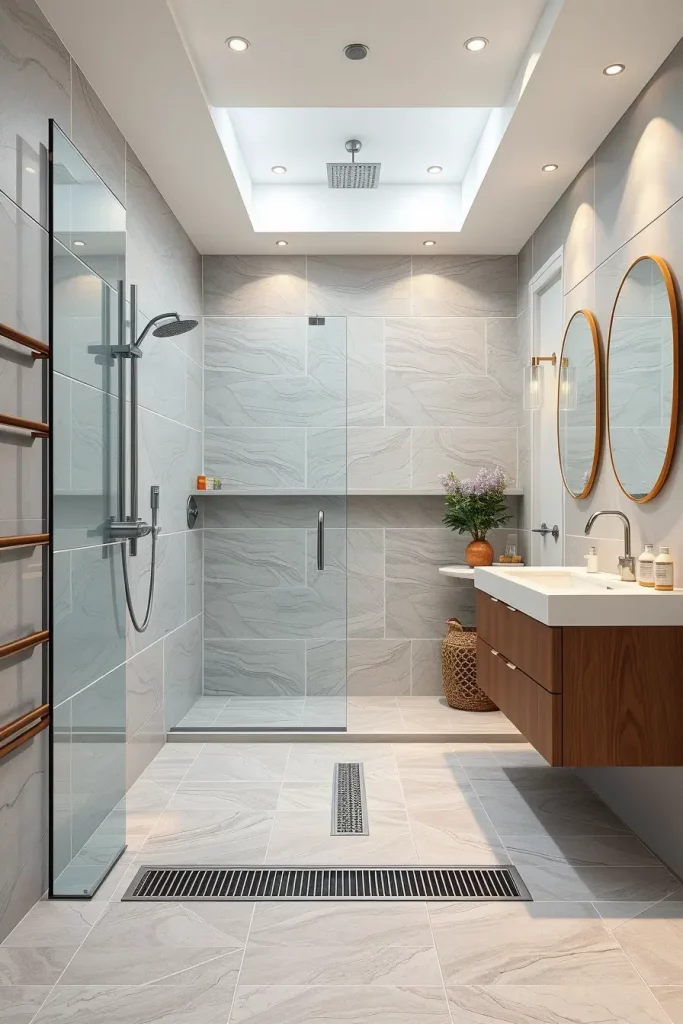
I usually slant the floor toward a linear drain, usually in line with the far wall. The lack of a step or curb makes it safe, particularly to aging-in-place houses, and clean. This design is ideal when used with frameless glass or glass partitions to optimize the flow of sight.

The thing that makes it an outstanding trend in my opinion is that it is two-functional, form and purpose. Interior Design Magazine says that curbless showers have become a luxury in residential and hospitality projects. I have applied them a lot in houses where the clients desire aging-ready designs but still ultra-modern.
To complete the perfect finish I would suggest a recessed wall niche to hold toiletries so nothing is on the floor and that clean, open look is preserved.
Built-In Niches For Functional Design
Adding built-in niches to the new modern bathroom design is one of the most useful changes I would recommend to the clients. Such inset shelves not only save space but also make clean lines and are not cluttered. This is because you can incorporate storage into the wall and this eliminates the use of large hanging racks or caddies, maintaining everything simple and minimalistic.
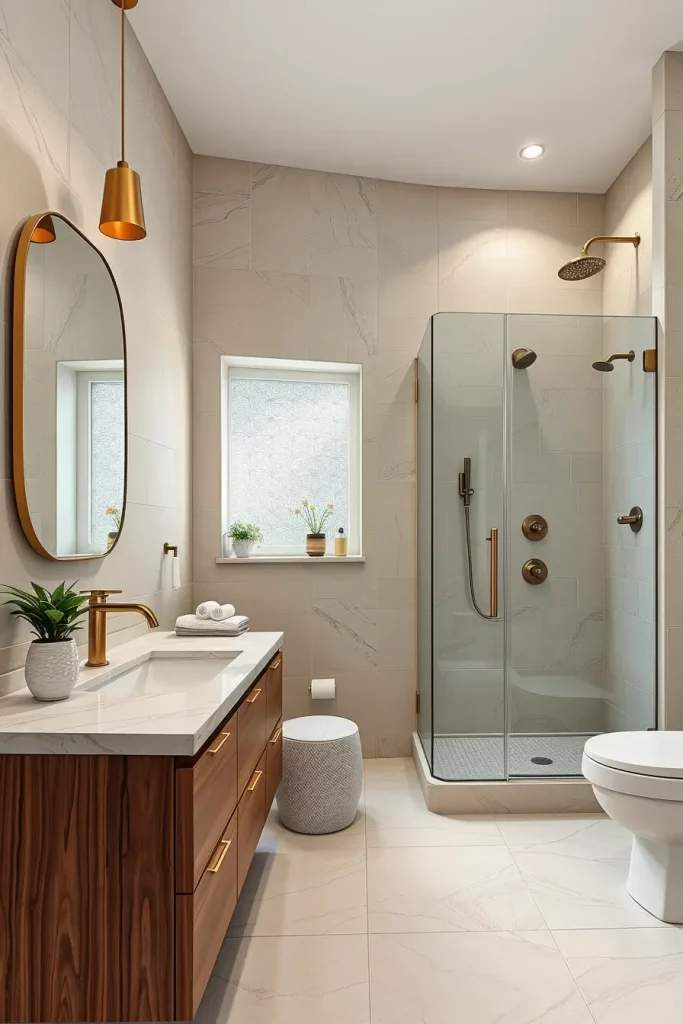
I frequently put these niches in showers and above bathtubs, depending on the needs of the products, I adjust the height and width. We usually line them with a matching or contrasting tile to add interest to the visuals- occasionally terrazzo surfaces or metallic trim to add cohesion. These are the best niches to keep soaps, shampoos and decor without interfering with the design.
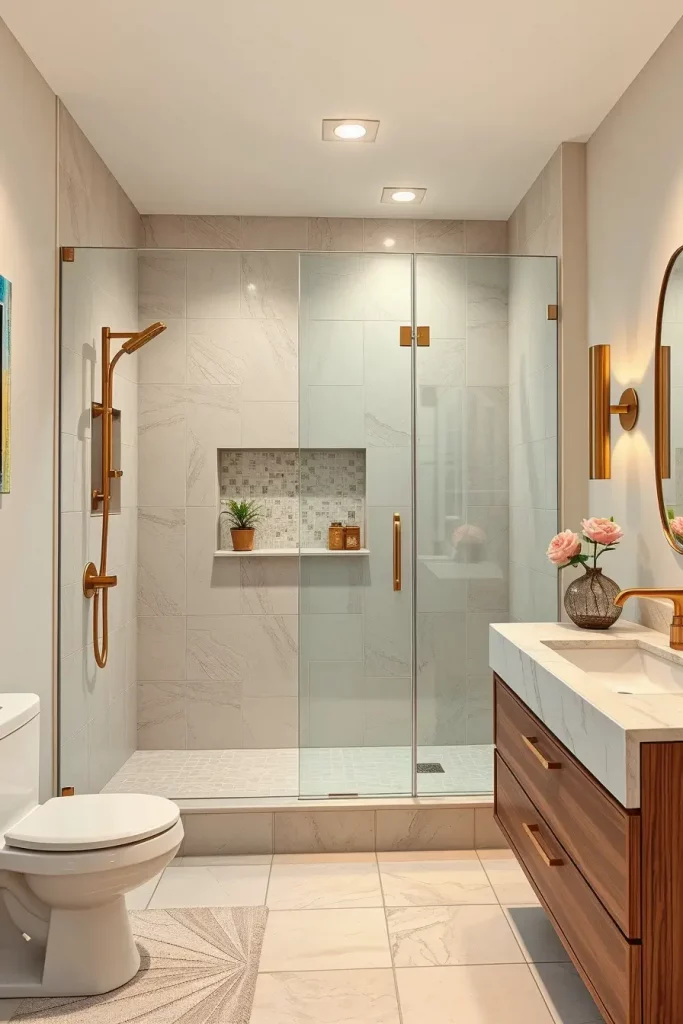
These are very unobtrusive and in my experience clients love them. According to House Beautiful, built-in niches have become a non-negotiable in luxury renovations not only because of their utility but because they look clean. I think they are particularly effective in combination with curbless shower floors, which adds to that open-concept effect.
To achieve a higher outcome, I would suggest the use of subtle LED strips in the niche. This does not only assist in the night but gives a boutique hotel feel to a normal bathroom.
Textured Wall Panels As Accent Features
Textured wall panels can add depth and warmth to a modern bathroom that is too sterile. I apply them as accent pieces- usually behind a vanity or bath- since they are a focal point that does not depend on a strong color. These panels are interesting, but they do not break the smooth tone of modern design.

I like fluted wood panels, ribbed cement boards, or 3D ceramic tiles, depending on the moisture exposure and the preferences of the client. They are frequently backlit or spotlighted by layers of ambient lighting in order to show the dimension of the texture. Together with floating wood cabinets, the outcomes are opulent yet understated.
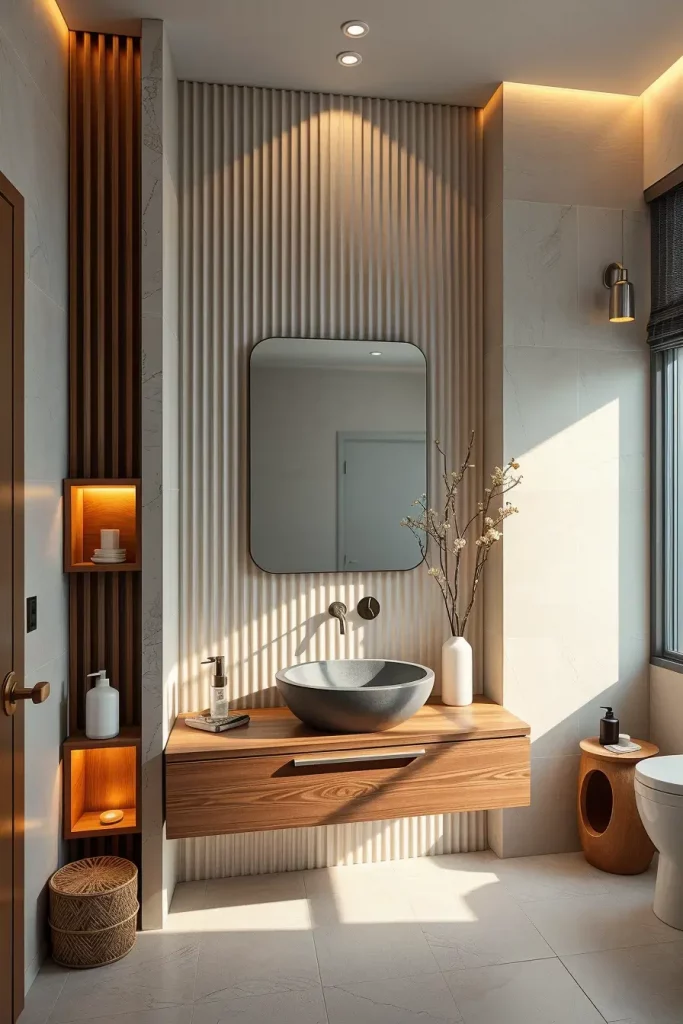
I especially like these panels when a customer needs a spa effect but does not want to use conventional decor. Livingetc describes modern wellness design trends as being focused on tactile details such as textured panels. I do they appeal to our desire to have softness in utilitarian places.
To finish the look, I would recommend wearing neutral colors such as sand, gray, or white and keeping the elements around minimal, so the texture can talk without noise.
Dual Showerheads For Luxe Experience
I suggest using two showerheads whenever clients desire to lift their everyday routine. This luxury feature does not only make it more usable, but it also makes the experience of a modern bathroom even better. Two fixed heads or a mix of handheld and rain shower, it brings spa-like comfort to the home.
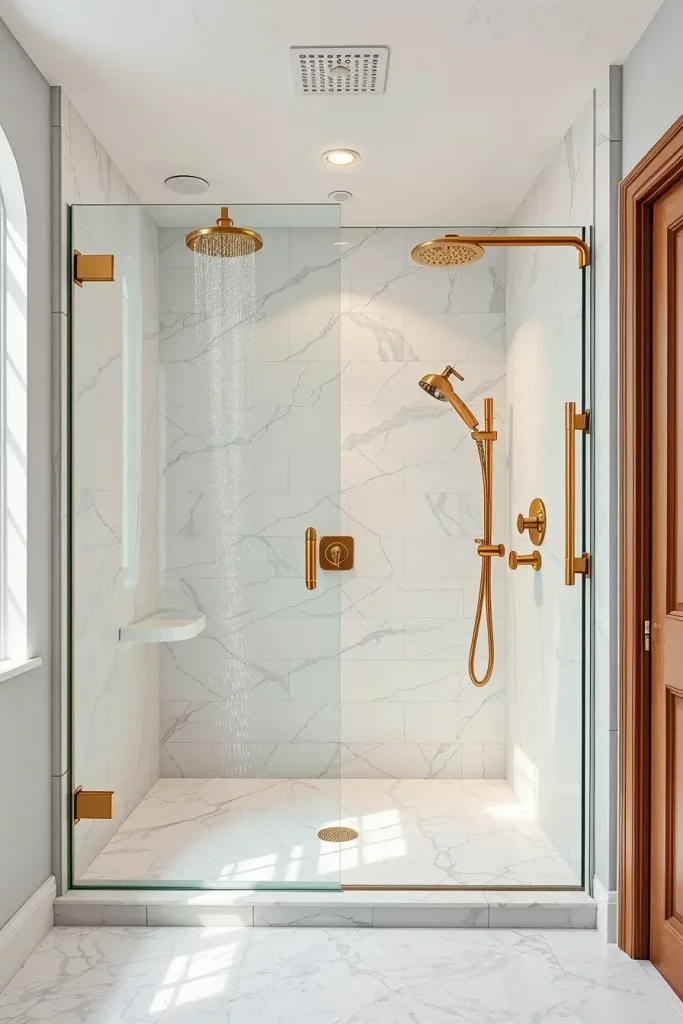
I normally have one wall mounted shower and one rainfall shower mounted on the ceiling. Both tend to be completed in brushed brass or matte black to match the hardware of the room. This combination with frameless enclosures and curbless floors is luxurious and carefree.
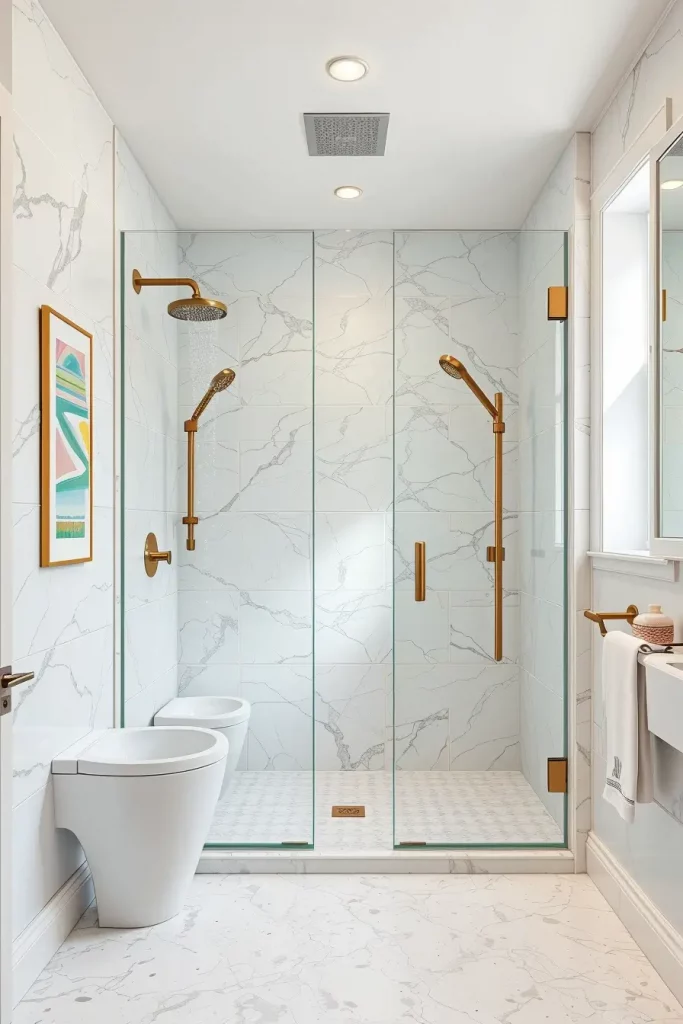
In my opinion, the flexibility is the value. Dual heads can be used to control temperature, adjust spray settings to individual preferences, and even shared with two people. This is one of the most wanted bathroom remodel features, according to Real Simple, particularly in master baths. I have witnessed it myself make ordinary places client favorites.
Where there can be an improvement, I would recommend to make it with a thermostatic valve system to have an easier control and a consistent water experience. The performance is worth the added expense.
Underfloor Heating Systems
Once you walk on heated floors in a contemporary bathroom, it is a totally different experience. I never fail to mention underfloor heating systems during my consultations, particularly in cold areas or in tiled bathrooms. They are an invisible luxury that makes a lot of difference in terms of comfort without compromising on the aesthetics.
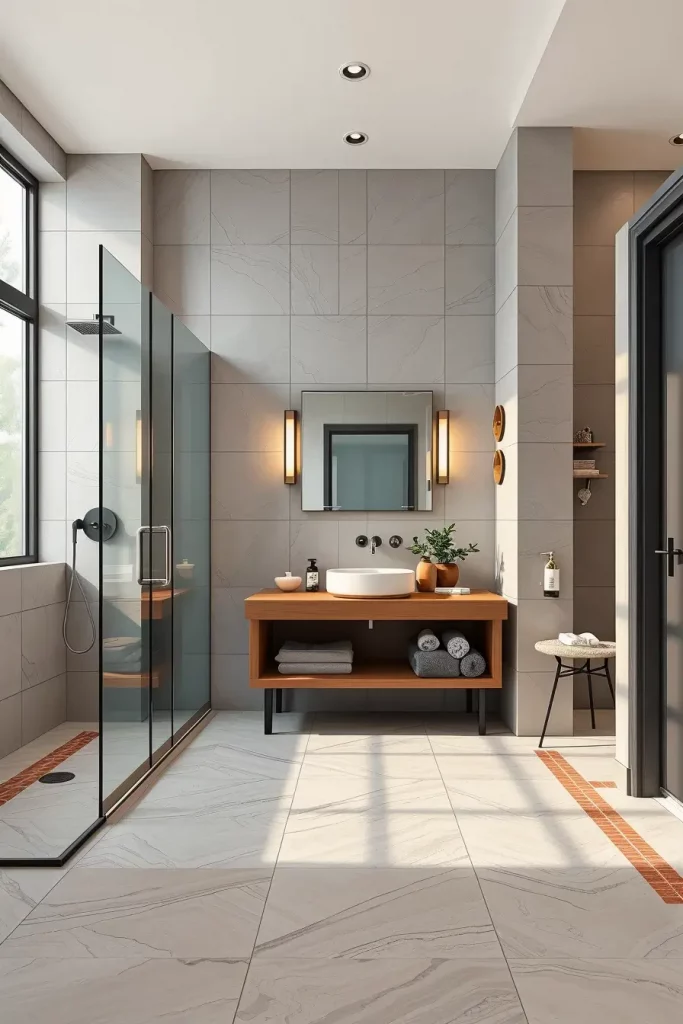
Electric radiant systems work best when under tiles, particularly porcelain or stone, which hold heat. I tend to combine this feature with curbless showers and large format flooring to create a spa-like, seamless design. The wiring is slender, thus it does not affect overall height and floating fixtures.
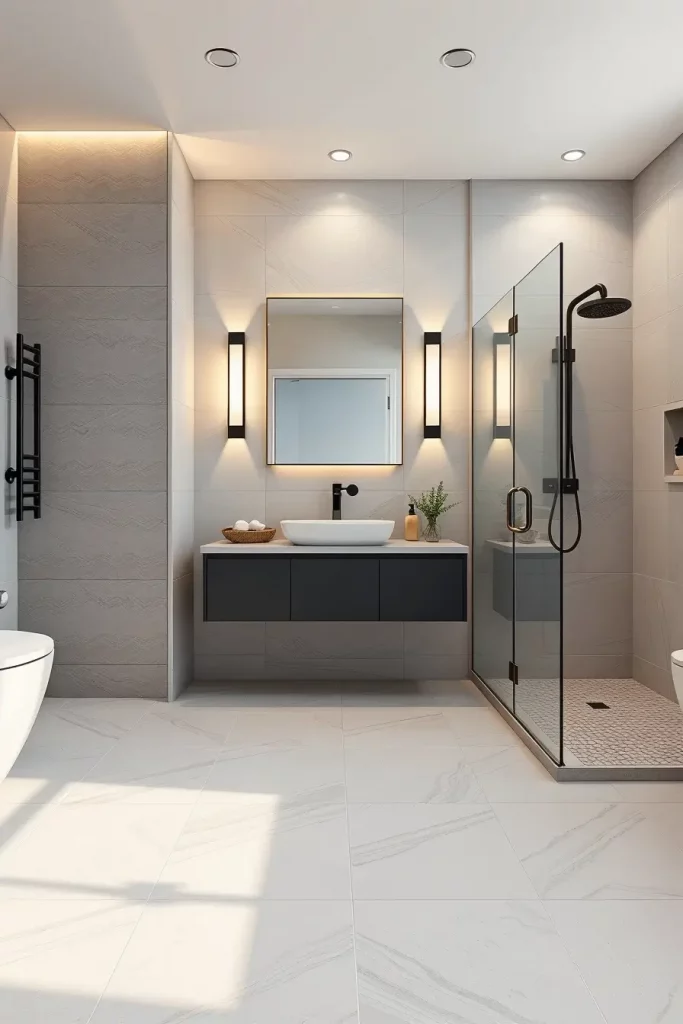
Clients report to me that it is one of their favorite upgrades. Even such publications as The Spruce mention it as an energy-saving and resale-enhancing feature. In bathrooms where little furniture is used or there is little heated air circulation, this system balances the distribution of warmth in a beautiful way.
Going a step further, I recommend combining underfloor heating with smart thermostats which enable you to program various zones and times of the day- there is nothing like waking up to warm tiles beneath your feet.
Glass Partition Walls For Visual Continuity
The modern bathroom design is assisted by glass partition walls to create a smooth open-plan style. I usually employ them to separate wet and dry spaces without disrupting the line of sight. These clear windows are bright and continuous, particularly in small or communal bathroom arrangements.
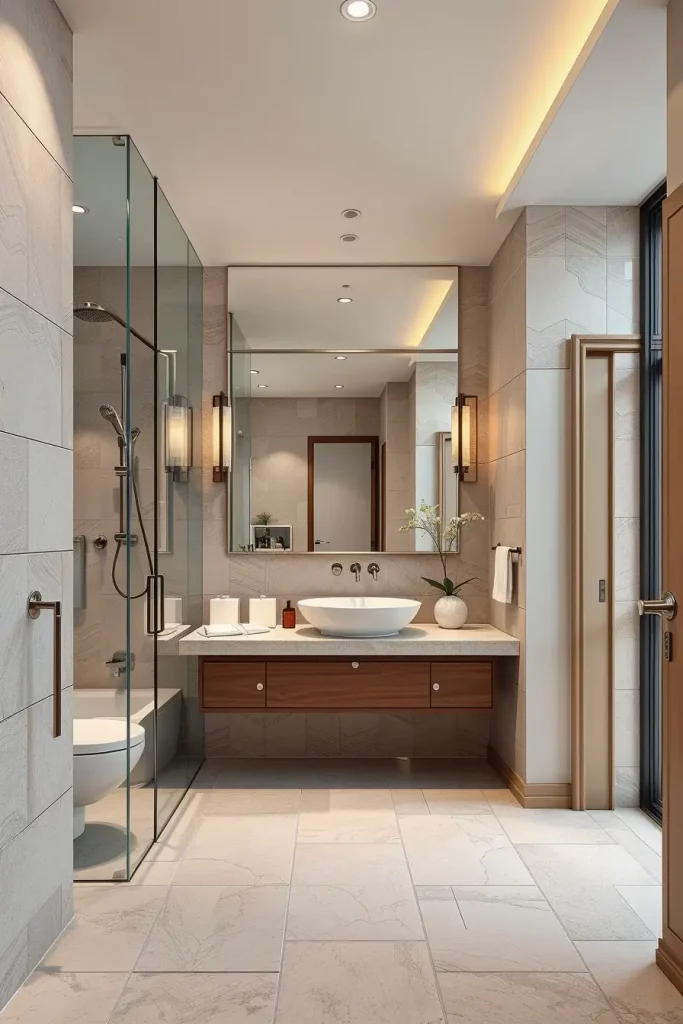
I normally use ultra clear or frosted glass, depending on the privacy that is needed. Floating cabinets and frameless showers are good in combination with floor-to-ceiling partitions or single panels. The fastenings are maintained at a minimum-usually matte black or brushed metal frames-so as not to overwhelm the visual plane.
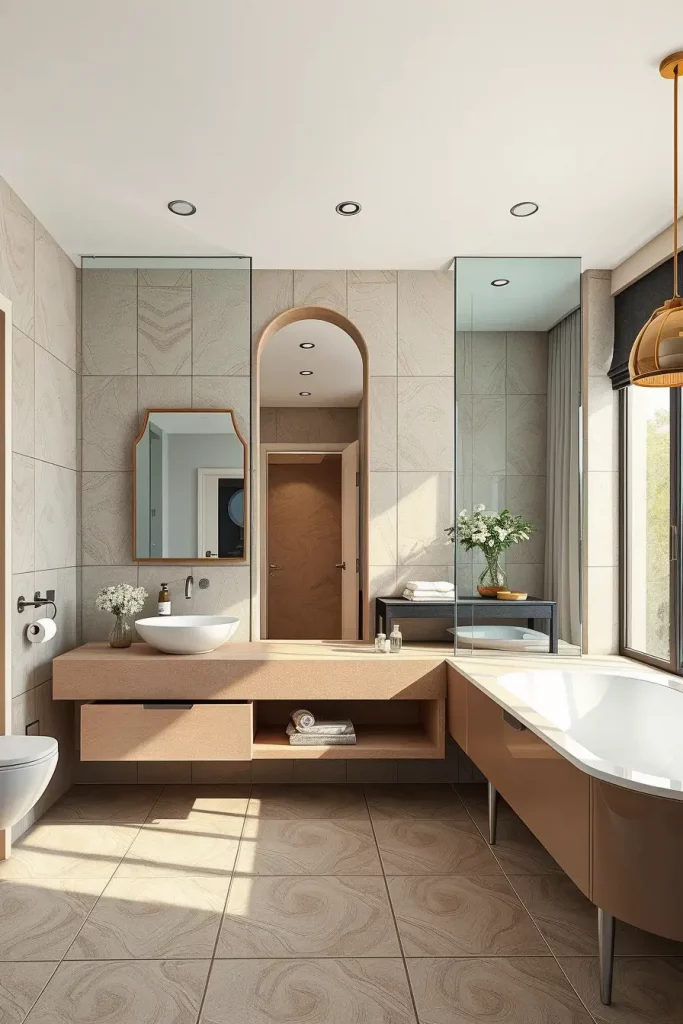
This is a design decision that to me shows the modernism love of light and flow. Dezeen has consistently posted bathrooms which have glass walls to obscure the division between areas whilst still controlling zoning. I also find it most helpful in small rooms that do not get a lot of natural light.
To make this section even better, I could recommend a textured glass variant: reeded or frosted, in case full transparency is too open.
Wall-To-Wall Mirrors For Expanded Space
Mirrors are a necessity in the bathroom but a wall-to-wall mirror provides a contemporary twist with dramatic payoff. I would suggest these large mirrors to make small bathrooms look airy and to reflect artificial and natural light.
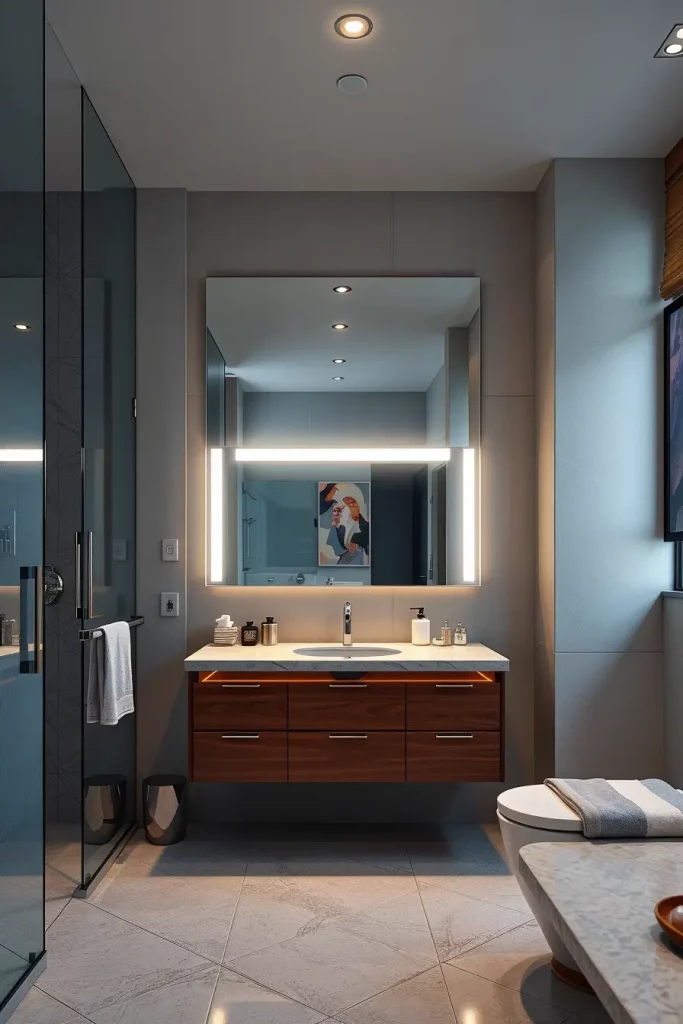
I tend to put one large panel over the vanity or a full wall panel above a floating wood cabinet. Frameless is desired, beveled edges or concealed supports. Provided there is space, I will insert a narrow mirror wall opposite a glass partition to create twice the illusion of depth.
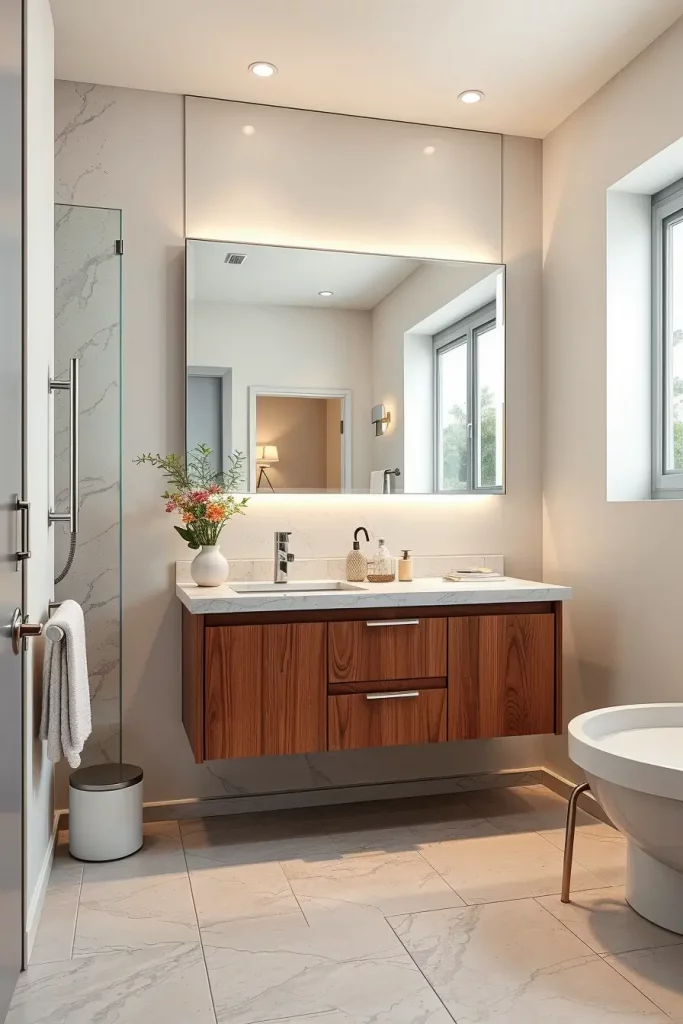
I think that one of the wisest things to invest in during a remodel is mirrors. Better Homes & Gardens shares the belief that full-wall mirrors make the space more clear and light more even. I have employed this ruse in powder rooms and apartment bathrooms a number of times.
To top it off, I would suggest adding backlit LED lighting along the edge of the mirror, which will provide both utility and ambiance without adding additional lighting fixtures.
Compact Layouts For Small Bathroom Design
Layout is the most significant element of the design when dealing with small bathrooms. I value smaller, efficient floor plans that nevertheless feel high and contemporary. All the necessities, vanity, toilet, shower, can be accommodated in a well-designed layout without being cramped or crowded.

I tend to move vanities into corners, put toilets on the wall, and use glass partitions or frameless showers to get rid of visual obstructions. Floating cabinets and mirrored walls add volume without adding to the footprint. All the details, including lighting, niche positioning, are taken into account to provide maximum flow.
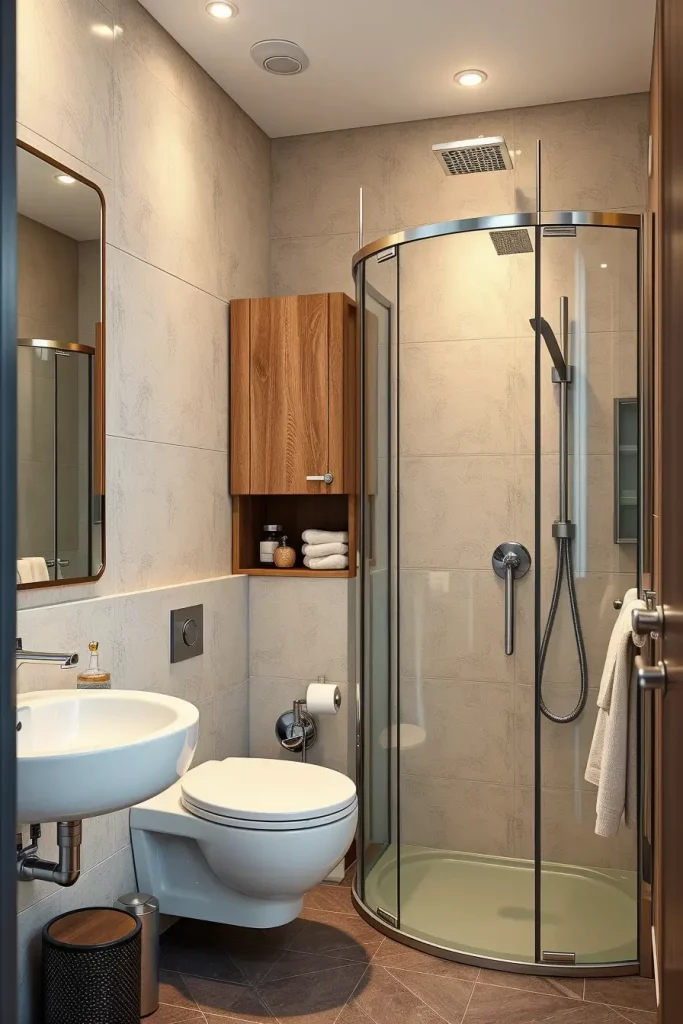
My own philosophy is that small is not less. I have made total overhauls of bathrooms as small as 45 square feet that are spacious due to accurate zoning. These kinds of clever makeovers are frequently featured in Apartment Therapy and I refer to them when I create my own designs.
To improve further, I would consider the possibility of custom storage such as narrow drawers or cabinets in the walls to keep the surface minimalistic but not at the expense of storage.
Japanese-Inspired Minimalism
One of the most calming modern bathroom trends I’ve worked with recently is Japanese-inspired minimalism. This design style focuses on clean lines, open space and a feeling of tranquility. It’s incredibly practical if you prefer low-maintenance elegance and want to avoid visual clutter. I would suggest this trend to clients who want an effective but calm environment-ideal to begin or end the day.

As far as the layout is concerned, the trend is characterized by a free-standing soaking tub, low profile wood or stone vanities, and wall-mounted toilets. Personally, I like lighter neutrals, including off-white, gray, and earth-toned color schemes, and natural materials, including bamboo, slate, or hinoki wood. Everything is deliberate, nothing is mere decoration and everything is constructed to be functional and light on the eyes.
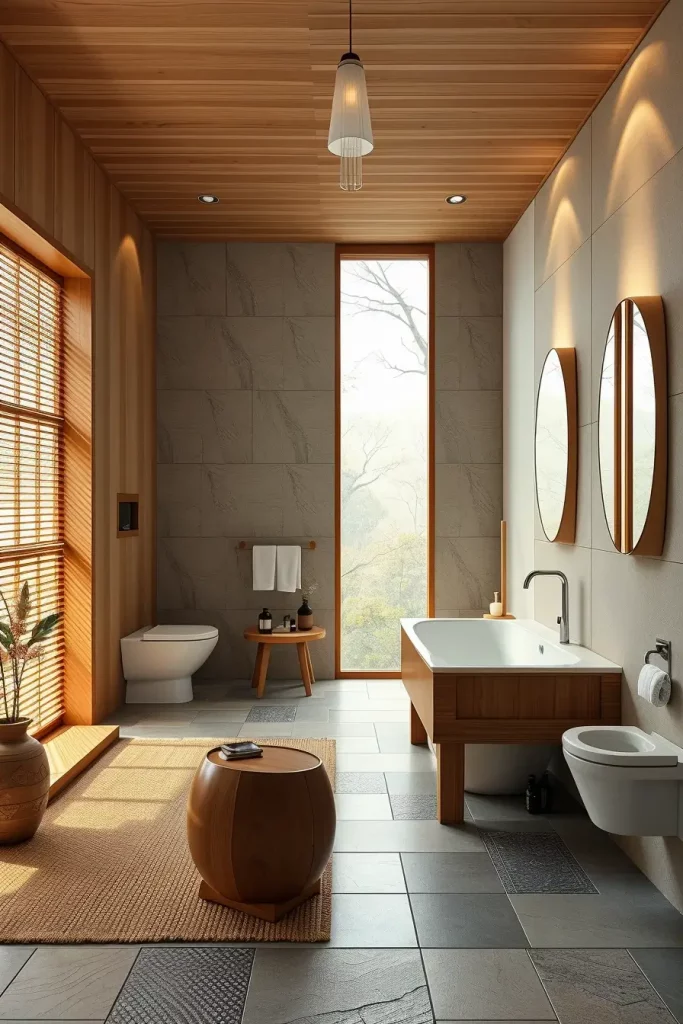
On a personal level, I have noticed that homeowners that embrace this style tend to find a newfound appreciation of daily rituals. Interior designers like Nate Berkus have pointed out that the Japanese concept of “Ma” — the space between things—can be as impactful as the design itself. I would go even further; the possibility of space and clarity is a great way to redefine our relationship with our homes.
I would also recommend the use of sustainable materials such as FSC-certified wood or recycled stone tiles that not only pay tribute to the minimalist spirit but also make the bathroom more environmentally friendly. The thing that is lacking perhaps is a little bit of green- a small bonsai or a simple house plant to introduce life into the room.
Earth-Toned Palette With Natural Materials
As far as my experience goes, earth tones and natural textures remain the most popular in modern bathrooms and with a good reason. These color combinations render a room earthy and classic. I have applied this method in apartments and homes in cities and in the countryside with amazing results. It is cozy, relaxing, and fashionable.
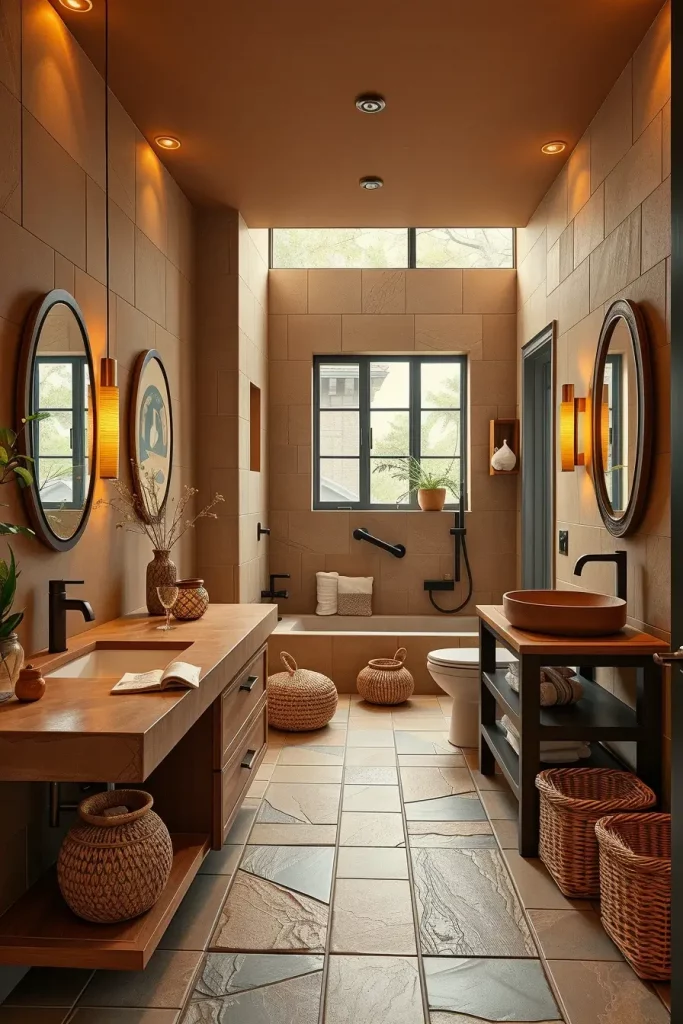
In this case, I tend to be attracted to such colors as terracotta, sand, moss, and dull clay. The combination with natural tactile materials, like woodgrain vanities, raw-edged stone countertops, woven baskets and textured clay tiles, lends a warm and natural feel. I prefer matte to glossy to give that natural soft feel.
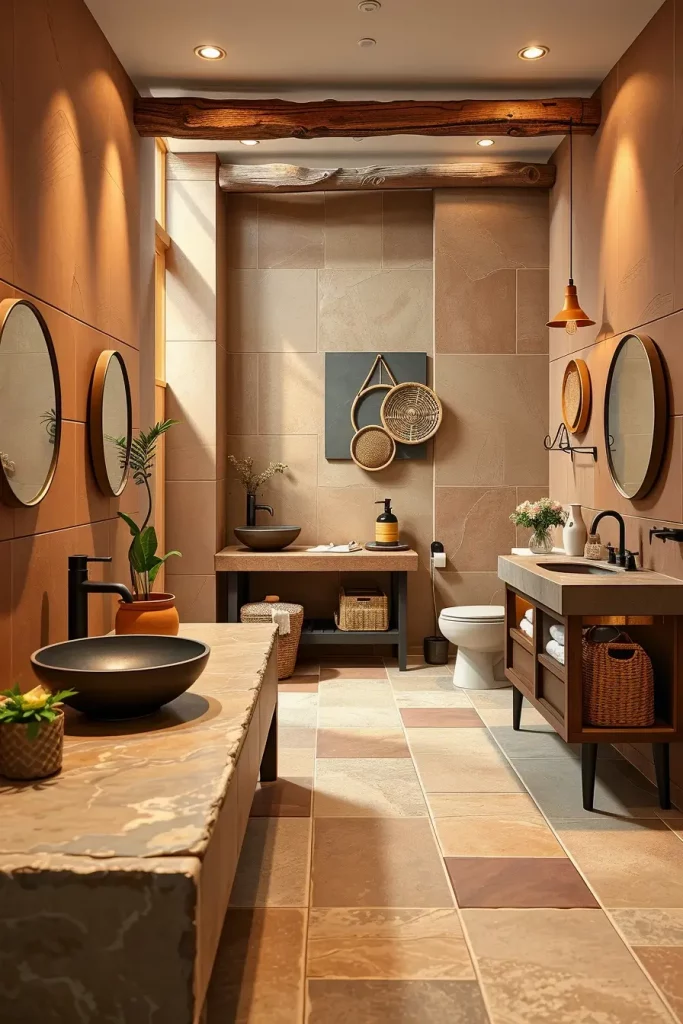
One of my favorite designers, Bobby Berk, has said that natural textures assist in filling the divide between the comfort of the indoors and the peace of the outdoors. In my opinion, that is particularly the case in bathrooms, where the sensory experience contributes so much to the way the space is used and enjoyed. On a personal level, I can say that the use of tactile contrast, such as a slate floor with a smooth stone basin, creates depths of visual and haptic interest.
The only detail I would suggest improving on this layout is contemporary lighting- give it a combination of dimmable warm LEDs and natural skylights, where possible. This will allow you to change the atmosphere between the active mornings and the relaxing evening soaks.
Space-Saving Furniture And Layout Ideas
In case of small apartments or city houses, space-saving ideas in the bathroom are a must. This has been one of the most convenient and at the same time fashionable modern bathroom trends in the recent past. It is simply a matter of smart design-get as much storage as possible without appearing cluttered. This renders any bathroom more practical without compromising its aesthetic quality.
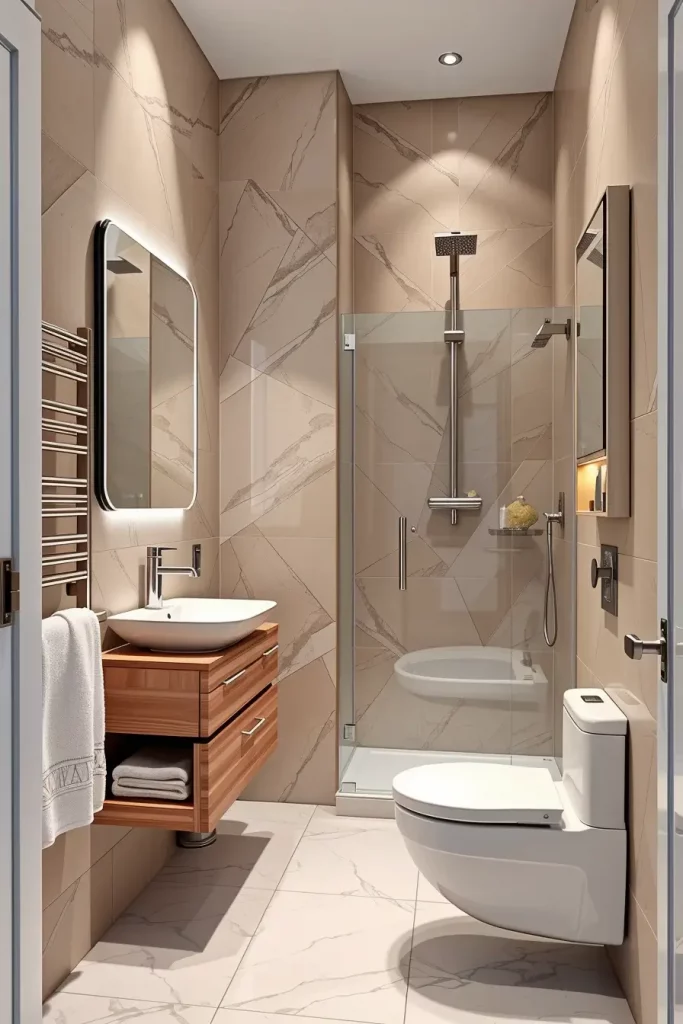
My recommendations of choice are floating vanities with drawers, mirrored medicine cabinets with hidden shelving, and fold-out or retractable shower benches. Toilets and wall-mounted faucets not only save space, but also add to a modern aesthetic. My projects are characterised by slimline vertical towel racks, under-sink drawers, and modular storage units.
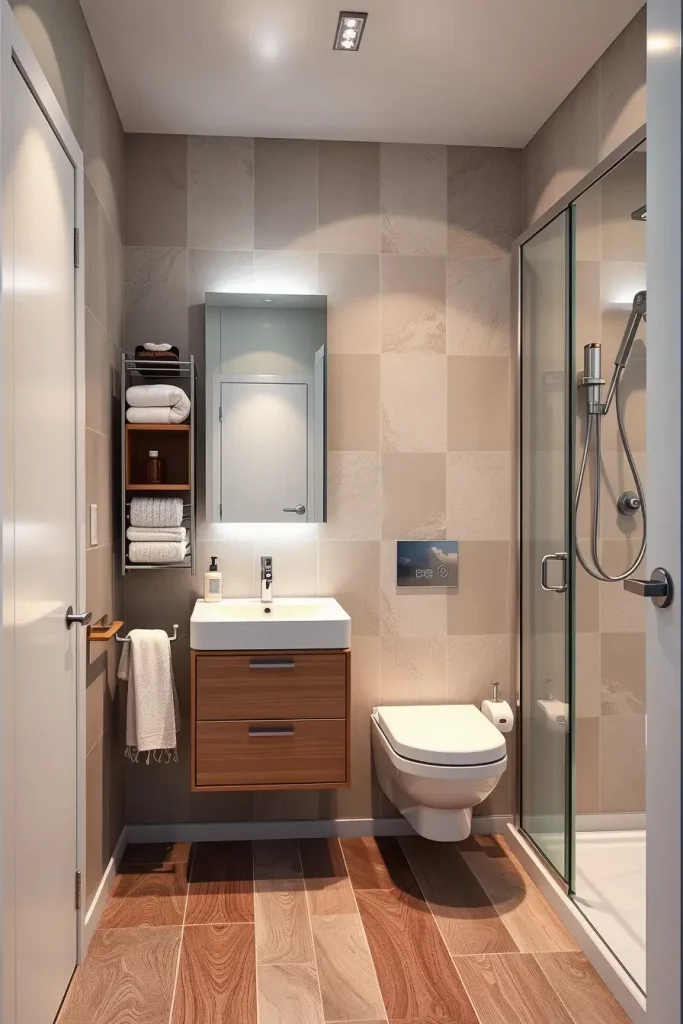
I’ve worked with clients who were amazed at how much space they could reclaim using these techniques. Recently, Architectural Digest had a small-space bathroom that incorporated a sliding barn door, floating shelves, and a frameless glass shower enclosure all great ideas that I have successfully implemented. It is really about multi-functional and vertical thinking.
The only thing I can think of to make this layout better would be some sort of integrated lighting in cabinets or drawers, like motion-sensor LED strips that come on when you open it. Such small details make the whole experience more valuable and correspond to the principles of smart design.
Sustainable Materials For Eco-Friendly Bathrooms
With the industry shifting towards greener living, I am increasingly getting clients who request the use of sustainable materials in their bathroom designs. This is not just a trend but it is becoming a norm. When constructing a new building or refurbishing, going green does not imply that you have to sacrifice style.
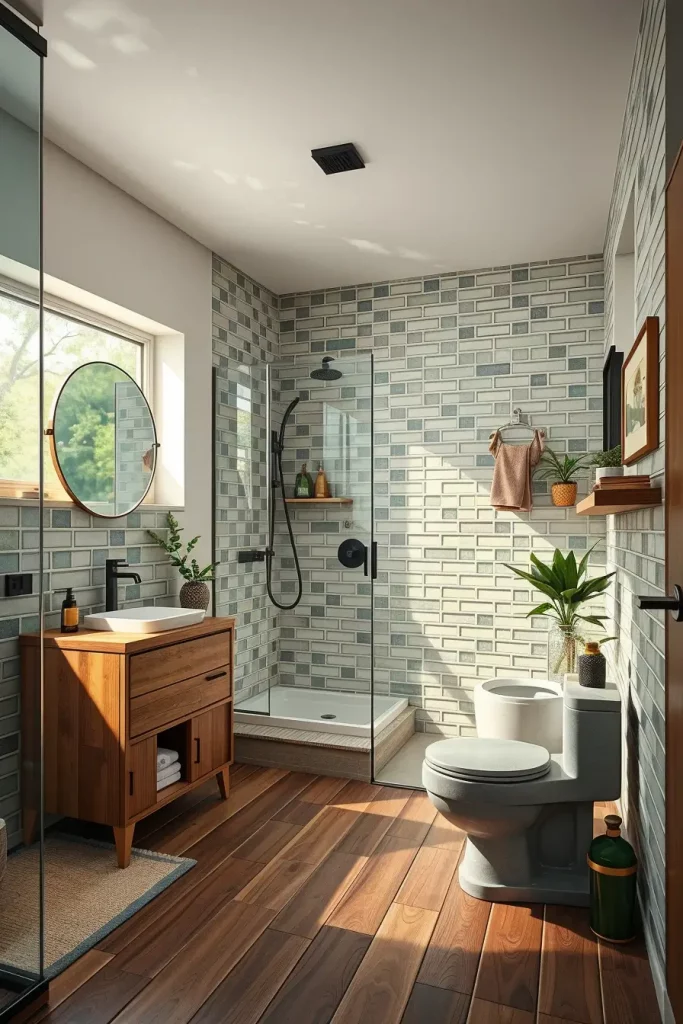
In my designs, I give first preference to recycled glass tiles, reclaimed wood in vanities, low-VOC paint, and bamboo flooring. Water-saving fittings such as dual-flush toilets and low-flow showerheads also matter. Not only do these materials appear beautiful, but they also fit into the long-term energy and water conservation objectives.
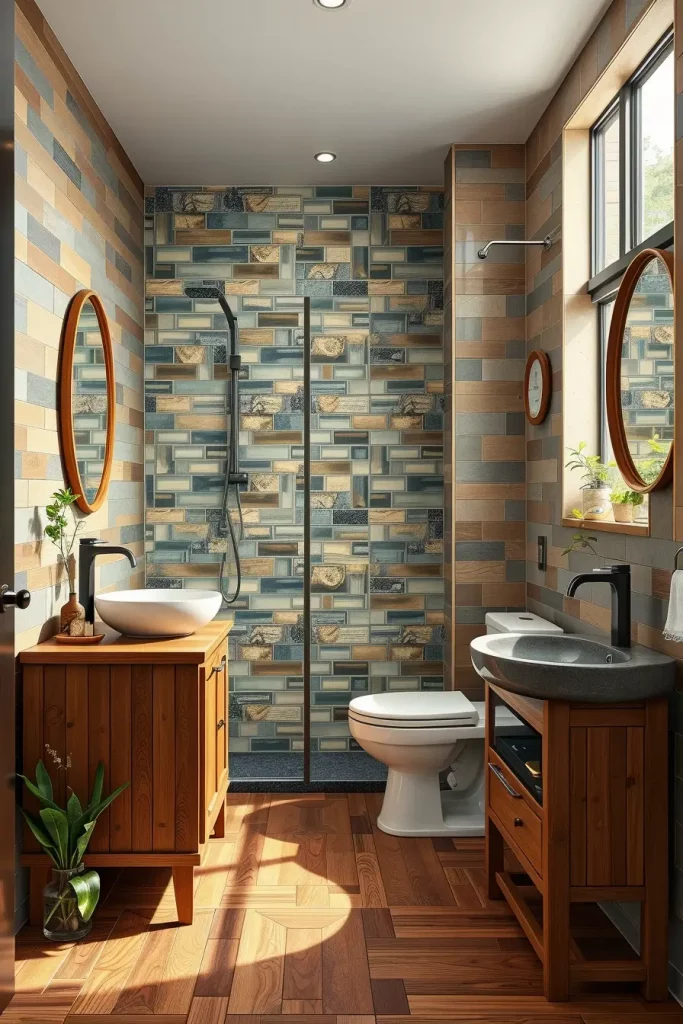
I had a case of a couple that was very much into sustainability. The walls were covered with recycled ceramic tiles, the sink is made of concrete, and the shelves are made of reclaimed wood. It came out great and worked even better. Even top designers such as Kelly Wearstler stress that sustainability and luxury are not mutually exclusive and you can indeed have both.
The only thing I would take further in this trend would be making these materials more accessible. Find local suppliers to reduce transport emissions, and look at brands of sustainable bathroom furniture that ethically source their materials. It is a means of making your house in line with what you believe in aesthetically and ecologically.
The current trends in the bathroom are not only related to the appearance, but also to the way we live, rest, and take care of the planet. Whether you’re drawn to minimalist serenity, earthy textures, smart layouts, or sustainable choices, each idea offers a path to a bathroom that’s both beautiful and practical. Which of these trends would you like to experiment in your own space? Share your thoughts in the comments below—we’d love to hear from you!
